Supporters Like You
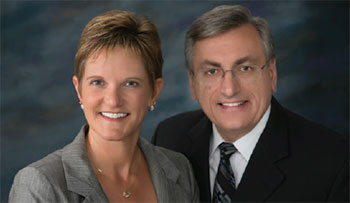
Janice Kurth
My SDSU story begins when we moved to San Diego 25 years ago, I knew nothing about SDSU at the time.
Read more of her story
What has SDSU meant to you and your family?
Our daughter earned her MS in the Department of Astronomy. The skills she learned have propelled her into a promising career with Apple. We have enjoyed our involvement with SDSU sports, theater and educational programs.
What are your hopes for the San Diego State University community in the future?
We hope that SDSU continues to be and further grow as a world class university, providing a prepared workforce, economic growth, entertainment offerings and intellectual endeavors in the San Diego region.
Leanne Babcock
My SDSU story begins with…A Spring Break trip to San Diego in March 2003.
Read more of her story
I was visiting a friend in the Navy and had never been before. I needed a new perspective. I was finishing up transfer requirements at community college and preparing to apply to two schools in Oregon. However, this spring break was different. The United States had just gone into Iraq. I was finally meeting with an Air National Guard recruiter after spring break to enlist in the Oregon Air National Guard. I wasn’t sure how I was going to become a student at SDSU and still pursue my dream of becoming an Airman. At the time, I was unaware there was an Air National Guard unit in San Diego. During my campus wanderings, I had stumbled across the Air Force ROTC Detachment, but no one was there.
I remember sitting at Scripps Pond going through all of this uncertainty and feeling complete bliss in that small nature preserve on an urban campus. I loved watching the turtles and koi.
After spring break, I enlisted in the Oregon Air National Guard 8 May 2003 as a Vehicle Mechanic and left for basic training in July. I graduated Air Force Basic Training 11 Sep 2003, but instead of going direct to my tech school I went back to Oregon. It was too late for me to start the semester so I went back to my old job while I waited for a tech school training date. Fiscal Year 2004 and the Base Realignment and Closure list came out, my Guard unit was on it. I was still going to tech school in January 2004, but I would need to find a new unit to go to before the end of FY 04. I was fortunate that my recruiter in Oregon found a small Air National Guard station in San Diego and they were willing to let me transfer after school.
After joint tech school with the Navy in Port Hueneme, I was able to make a trip to San Diego and meet the Air Force ROTC cadre and my recruiter for California. On 18 May 2004, I officially transferred from the Oregon to the California Air National Guard. I moved from Oregon to San Diego in June and started working my plan to transfer to SDSU and complete the Air National Guard/Air Force ROTC Simultaneous Member Program. My major roadblock was a lifelong struggle with Dyscalculia. I was formally diagnosed after I sought out an academic counselor who evaluated me. At that point, I was embarrassed and had failed the math class I needed to transfer to SDSU. I had previously failed seven math classes in three years of college. Having an answer gave me the confidence to work with tutors, practice interventions, and quell the fear of failure to keep me from achieving my goals.
It took me two denials and a probationary acceptance to get into SDSU, my first full time semester was Spring 2006. I threw myself into organizations within Air Force ROTC, continued working as a nanny, and led a delicate balance as a Citizen Airman. During 2007-2008, I was deployed twice and activated for California Wildfire support. I found a group of Veterans who gathered at a small office that doubled as the Veterans Center. This group was formed by Marines and Sailors who became fast friends. They made sure I was introduced to Joan and able to access my benefits. They also encouraged me to work with my professors during periods of mobilization so I could graduate and commission on time. This group would become the Student Veteran Organization. That year was a blur, I was taking an average of 18-21 Credits, living a dual life as an Airman and cadet, and still trying to work.
With much support from my friends in the Student Veterans Organization, Veterans Center, my shipmates in the 147th Combat Communications Squadron, Air Force Association, Silver Wings, and Air Force ROTC…I graduated from SDSU in May 2008 and Commissioned as a Second Lieutenant in the United States Air Force in June 2008.
What has SDSU meant to you and your family?
I am immensely grateful for SDSU being the foundation for my future. I am fortunate to have been at SDSU as a Student Veteran during a time of transition.
I am the first college graduate in my family, the first Airman, and the first Air Force Officer. All of those would not have been possible without the immense support network and my Mom encouraging me to preserve.
My cousin is an SDSU Class of 2021 graduate, we now share a special bond of being #AztecForLife
What are your hopes for the San Diego State University community in the future?
Continue to feel like home every time you step foot on campus and find yourself wandering to Scripps Cottage to see the turtles, to the War Memorial to honor those Aztecs who gave the ultimate sacrifice, and to the alumni center where we reflect on our proud heritage.
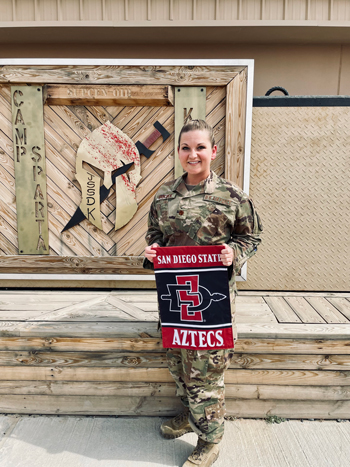
“I am immensely grateful for SDSU being the foundation for my future. I am fortunate to have been at SDSU as a Student Veteran during a time of transition.”
-Leanne Babcock
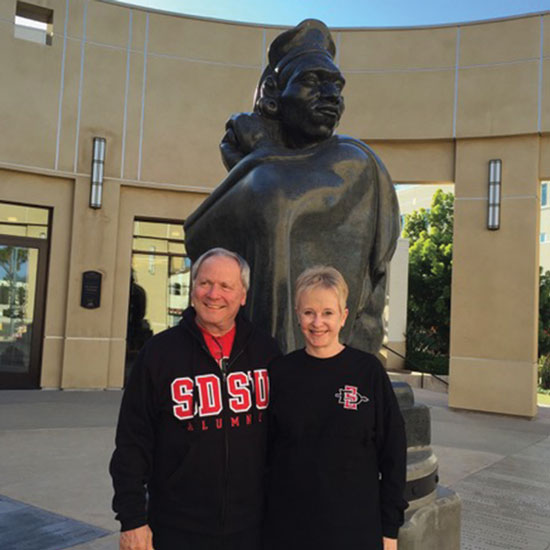
Gerry and Patsy Kirk
Gerry and Patsy Kirk met in the Marching Aztecs when Gerry was a graduate student helping to develop football halftime shows and Patsy was a freshman baton twirler. They dated on and off for five years while Gerry pursued his teaching career.
Read more of their story
Patsy and Gerry love SDSU because of the quality education they received, for the excitement of all the special programs like basketball games and for the many opportunities the University offers college students today. By establishing endowed scholarships for undergraduate students at SDSU, they’re helping future generations of Aztecs achieve their dreams.
You can join the Kirks in showing your Aztec pride and love for SDSU is as strong as ever—after all this time—with a legacy gift this Valentine’s Day. This type of gift costs you nothing today, but it enables San Diego State University to change students’ lives and empower them to make the world a better place for years to come.
Is SDSU already in your future plans? Let us know by contacting Amy Walling at (619) 508-9255 or awalling@sdsu.edu.
Tammy Blackburn
The adult heart is roughly the size of a fist, weighs about 11 ounces and pulses at 60-100 beats per minute. That’s the average heart, but certain human hearts are different. Tammy Blackburn’s is stronger than most and more resilient.
Read more of her story
Blackburn’s long and arduous battle with cancer lasted nearly a year. After the initial shock of the diagnosis, she asked—as most people do— “why me?” The eventual answer was no surprise to anyone who knows Blackburn. “I was meant to do something with this.” Immediately, her thoughts turned to the San Diego State University community.
Blackburn is Director of Marketing and Communications, at SDSU, a double alumna (’94, ’01) and a long-time donor to SDSU. The university athletics recruited her, and she became a standout guard for the women’s basketball team in the 1990s. Her legendary positive attitude inspired SDSU to create the Tammy Blackburn Award, given annually to the student-athlete who epitomizes loyalty, effort, athletic prowess and team spirit.
As Blackburn underwent treatment, she began to wonder if there was an unmet need among SDSU students affected by cancer. “I don’t want SDSU students forced to make a decision between school and medical bills. I don’t want them dropping out,” said Blackburn. When financial aid administrators confirmed her suspicions, she settled on a name for what she would create—the Wallace Shatsky Blackburn Courage Through Cancer Fund, named for the UC San Diego Health doctors who saved her life.
“Working on this fund, named for them and directed to SDSU students, has been a giant healing step—psychologically and emotionally.”
“Tammy’s fund will help us to help students faster,” said SDSU Financial Aid and Scholarships Director Rose Pasenelli. “This fund will help us set students up for success on the front end instead of stressing all the way through the year and trying to scramble and find money wherever we can.”
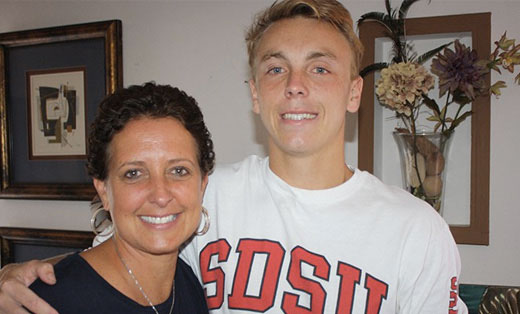
“The most important thing we could do at this point in our lives was to help kids go to school. It’s the right thing to do.”
-Patsy Kirk
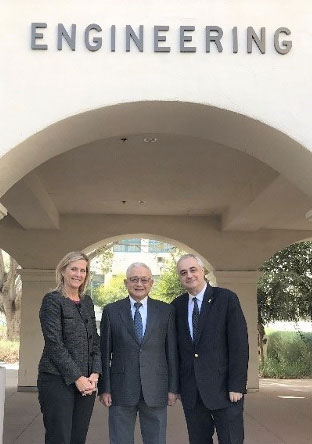
Dr. Andrew Y.J. Szeto
As a student who always liked math and science, Dr. Andrew Y.J. Szeto discovered engineering when he used recycled batteries and parts from a hardware store to build a DC motor and entered it in his middle school’s science fair, and thus began a lifelong career in education, engineering and science.
Read more of his story
Prior to joining SDSU, he was on the faculty of Biomedical Engineering at Louisiana Tech University where he led their rehabilitation engineering research and development efforts. He has held industrial positions with the Northrop Grumman Corporation, Tanner Research & Development, La Jolla Technology, Inc., and Hughes Aircraft Company.
During 1999-2001, he served as the President-elect, President, and Past President of the IEEE Engineering in Medicine and Biology Society. He is a member at various times of IEEE, Tau Beta Pi, Sigma Xi, the Biomedical Engineering Society, Human Factors and Ergonomics Society, and American Society for Engineering Education.
In recognition of his professional activities, Dr. Szeto was elected fellow of the Biomedical Engineering Society (2005); Fellow of the American Institute for Medical & Biological Engineering (March 2002); and Fellow of the IEEE for “Contributions to Rehabilitation Engineering,” (Jan. 2002). He also was chosen as the “Most Influential Professor” by the College’s valedictorian in 2006, 2016, 2017, & 2018.
According to Szeto, much of his professional and financial fulfillment can be attributed to SDSU. In gratitude for the career that he has enjoyed at SDSU, he is paying it forward by providing opportunities for others to achieve their dreams. This will be accomplished with a $50,000 gift to the Rehabilitative Engineering and Assistive Technology Program at SDSU to support travel, senior design projects, graduate student projects, stipends and etc. in the program.
Paul and Wendy Rosengard
Paul Rosengard graduated from San Diego State University in 1977 with a degree in Kinesiology, and received his teaching certificate from the university in 1978.
Read more of their story
SPARK is dedicated to creating, implementing, and evaluating research-based programs to improve the health of children and adolescents, and promotes wellness throughout the lifetime. Considered the “Godfather” of the SPARK Program, Paul first joined the SPARK research team in 1990, and served as the program’s Executive Director from the beginning of dissemination in 1993 until his retirement in 2015.
Paul is known for his extensive work as a content author, teacher trainer, and physical activity leader, having contributed as an intervention director and consultant for many benchmark national studies / projects throughout his career. These studies focused in the fields of physical education, after school programs, early childhood, and coordinated school health.
While leading the SPARK dissemination effort, Paul taught future teachers how to instruct physical education at UCSD for 11 years. He has over 25 publications/papers/magazine articles in professional journals, has authored or co-authored 16 curriculum books for teachers, and has conducted nearly 400 professional workshops and conference presentations worldwide. He was appointed as the first Deputy Director of the California Governor’s Council on Physical Fitness and Sports (1996), and served as a key member of the education committee for many years. Before returning to SDSU in 1990 to work on the first SPARK research grant, Paul taught for 12 years as a physical educator, athletic director, department head, and sports coach. He’s also proud of his years as a Recreation Leader with the Chula Vista Parks and Recreation Department (which put him through SDSU) in his hometown of Chula Vista, CA.
Together with his wife Wendy, Paul is establishing three endowed funds within SDSU’s School of Exercise and Nutritional Sciences.
The SPARK Endowed Scholarship will provide support to students pursuing the Fitness Specialist concentration in Kinesiology who have financial need.
The SPARK Endowment for Student Research and Scholarly Activities will enhance the educational experience of students by supporting expenses related to research, conference travel, and other high-impact practices that contribute to the academic experience of students.
The SPARK Endowment for Faculty Research will support expenses associated with faculty research.
“SDSU has been a big part of my life. From 1974-79 as a student; from 1990-2002 as an employee, and through our partnership with SPARK from 1990-2015 when I retired. I’m grateful to have an opportunity to give back to SDSU, and I strongly encourage my fellow alumni to do the same, and join me in becoming a member of the Heritage Society,” shared Paul.
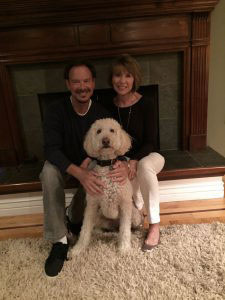
“I’m grateful to have an opportunity to give back to SDSU, and I strongly encourage my fellow alumni to do the same, and join me in becoming a member of the Heritage Society.”
-Paul Rosengard
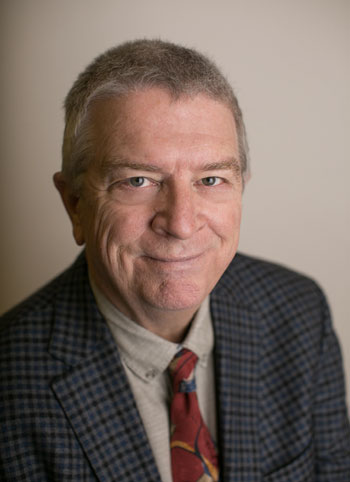
Richard Robbins
The saying “Work hard, play hard” resonates for many. For SDSU alumni Richard Robbins, the life motto is “Be kind to others and patient with yourself.” It’s these standards that have helped Robbins achieve the success he’s always dreamt of.
Read more of his story
During his tenure of teaching, Robbins has won numerous awards including the Kay Sexton Award for long-standing dedication and outstanding work in fostering books, reading and literary activity in Minnesota. Fellowships from The Loft Literary Center, the McKnight Foundation, the Minnesota State Arts Board, and many more have also been highlights of Robbins’s career. Adding to the vast career achievements, Robbins has also published six books of poems.
This successful career in writing would not have been possible if not for the community of writers that SDSU provided. “My sense of myself as a writer who belonged to a larger community of writers grew substantially…when an astounding number of poets visited SDSU and the greater San Diego community,” remembered Robbins. “We were not used to such abundance. It put a fire under us all. And it had a great influence on me when, ten years later, I started directing a reading series of my own.”
Robbins’ college years were also extremely different in several ways. “You are moving forward but only with enough light from your flashlight to see a few steps ahead,” said Robbins. “There are no guarantees as to where you are headed, only the feeling that for now you are headed in the right direction.” But a much-needed class, or conversation with a professor provided magical experiences as well. And it was the culmination of these that provided Robbins with the quintessential college experience, something he is forever grateful to have had.
Richard and his wife, Candace Black, have cemented a legacy to SDSU in the form of a planned gift. They are motivated by the reality that higher education is now increasingly expensive but “also by the experience of working with people who saw potential in us and somehow managed to help us see it too,” said Robbins.
Brian Miller
It only takes attending one game, match, or event to understand why SDSU Athletics has one of the most dedicated and loyal fan bases in the country.
Read more of his story
Brian’s experience with SDSU athletics came when he was hired by the Aztec Athletic Ticket Office. Here, he was tasked with influencing Aztec football and basketball fans to purchase game and season tickets for those programs. “I had so much fun working in the ticket office,” remembered Brian, “My family was/is from the mid-west but they could see how much I enjoyed myself in San Diego and working for SDSU athletics. To that extent, they were happy for me that I found a ‘home’.”
Behind all the touchdowns, home runs, and baskets, there is a side to athletics that most fans are not aware of. Employees like Brian are essential in providing fans the opportunity to cheer on their team.
Despite his love for SDSU Athletics, Brian understands the importance of universities being a sanctuary of higher learning. Forwarding the athletics programs cannot happen without the continuous improvement of the university campus that provides opportunity for many.
“I was there when the ‘old’ campus was rebuilt and reinvested into a modern, state of the art, beautiful ‘new’ campus,” said Brian. It was because of this improvement that “the seeds were planted for raising the quality and competitiveness of the athletics programs.” The goal for Brian: “I’d love to see the university thrive and offer its students, and San Diego, the best of both worlds.”
Brian is looking to make this goal a reality by continuing his support of SDSU with a planned gift. It’s with this fighting spirit that SDSU can achieve its long-term goals of becoming a nation leading university. In the words of the Aztec “Fight song”, “We will fight till victory!”
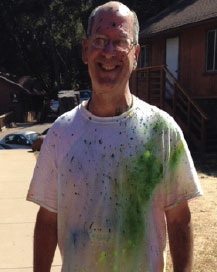
“I’d love to see the university thrive and offer its students, and San Diego, the best of both worlds.”
-Brian Miller
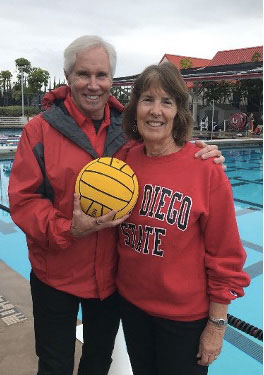
Chuck and Kathy Mendenhall
Meeting at a “Hello Dance” in the old Student Union proved to be a great start for Chuck and Kathy Mendenhall. As a first generation college student from the Bakersfield area, Chuck came to SDSU to study engineering.
Read more of their story
Like the recent Hollywood movie Hidden Figures, Kathy was a real life human computer. She worked for Computer Sciences Corporation, known as CSC, a huge international company with an office in San Diego. She worked on a project that was a contract with the US Navy on Point Loma. She started as a computer programmer, then a computer scientist on a project that maintained and upgraded the program in the Navy’s E-2B/E2C airplane.
Chuck’s first job after SDSU was with the San Diego County Building Department. He started as a Junior Civil Engineer and ended his time there as a Senior Structural Engineer. After leaving the County Building Department, he joined a small start-up engineering company named EsGil Corporation. It was an engineering services company that contracts services to cities, school districts, CSU and UC systems to provide state required building code and life safety code compliance. The company grew from six employees and three contracts when he joined to 50 employees and approximately 100 contracts in five western states. He became a minority partner in the company, which was aquired in 2016.
Chuck and Kathy are long time donors to SDSU with their first gift of $15 in 1975. The Mendenhall’s provide support across campus to Athletics, Engineering, Sciences, Guardian Scholars, Men’s Basketball, Women’s Water Polo, the EIS, the new stadium and the AGC Chair in Construction Management. Their generous giving makes an impact campus wide.
Randi McKenzie, M.Ed. and Thom McKenzie, Ph.D.
The McKenzies arrived at SDSU as faculty members in August 1980 and they continue to serve the University.
Read more of their story
Thom McKenzie, Ph.D., officially retired as emeritus professor in the SDSU School of Exercise and Nutritional Sciences in 2004. A native of Canada, he is a former school physical education and health teacher, coach, and administrator. He also served as a technical consultant with the USA National and Olympic Volleyball Teams for 16 years. Dr. McKenzie has authored/co-authored approximately 300 scientific papers and chapters, presented at over 500 international, national, and state conferences, and served on numerous national committees and task forces. In his own words, despite humble beginnings, he has “traveled broadly, participated in the Olympics, dined with a president, and received more recognition than ever imagined.” Through his research and scholarship (which continues and includes being on NIH-funded grants through the SDSU Foundation), Thom truly has impacted society in a most profound manner. He, for example, is co-founder of SPARK (Sports, Play, & Active Recreation for Kids), an internationally recognized, evidence-based, physical education curriculum and instruction program that is now in its 31st year.
Randi notes, “I have received a great deal from working and volunteering with the students, faculty, and staff at SDSU. Having spent 40 years on SDSU’s campus, I wanted to repay the university for the privilege of working with those from whom I have learned so much.”
Randi and Thom have included SDSU in their estate plans. Their gifts support a KPBS programmatic endowment, the SDSU Emergency Crisis Response Team, and the SDSU Courage Through Cancer Fund. Additionally, they annually support student research within the School of Exercise and Nutritional Sciences as well as the Performing Arts Traveling Troupe, a Bystander Intervention and Sword Fighting program, and Children’s Theatre within PSFA.
We are so grateful for all that Randi and Thom do for SDSU and the broader community.
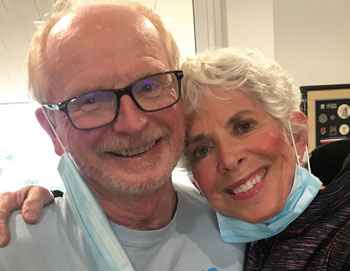
“Having spent 40 years on SDSU’s campus, I wanted to repay the university for the privilege of working with those from whom I have learned so much.”
-Randi McKenzie, M.Ed.
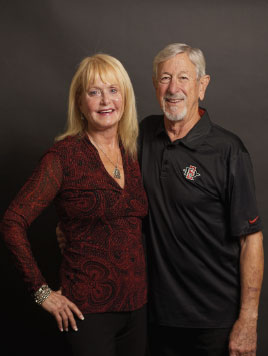
Jim Marshall ’74 and Deborah Marshall ’79
Jim Marshall ’74 and Deborah Marshall ’79 both were already proud Aztecs when they had their first date tailgating at an SDSU football game in 1981.
Read more of their story
Grateful for the educations that launched their careers and just as grateful for the athletic connections that are such a huge part of their lives, the Marshalls have made a bequest through a trust that will support SDSU athletic programs long into the future.
Jim began his journey at SDSU majoring in psychology and drama with a minor in english and participated in a lot of plays. Deborah majored in business management, graduating with high honors with distinction in her field as a member of the National Honor Society of Phi Kappa Phi and as a member of Beta Gamma Sigma; she also did graduate work in information systems. They didn’t meet until after both had graduated.
“Our continuing connection with the university is based on our connection with student-athletes and with athletic department staff, administration, and coaches,” the Marshalls say. “We consider them our extended family.”
And both Marshalls are extremely active “family” members. Besides being regular donors, football and basketball season ticketholders, and Aztec Club members, Jim is on the executive board of the Aztec Club and a member of the Campanile Foundation Athletic Committee and the Inter-collegiate Athletic Committee.
The Marshalls’ have named SDSU in their estate to create a fund in their names that will provide financial support for student-athletes at SDSU and for the athletic department. The Marshalls say they chose to give via a bequest because it provides flexibility for them and for the university.
Erik Johannsen and Rebecca Long
A large university like SDSU allows the opportunity for each student to have varying experiences. This holds true for Erik Johannsen and Rebecca Long. Both graduates from SDSU but their paths were vastly dissimilar.
Read more of their story
The hard work would pay off for Rebecca, however, as she would go on to be a nurse for 40 years. During this time, she also served as SDSU Nursing Faculty for 12 years, a position she touts as the “Best job ever.” Rebecca also served as a health policy fellow for a senator, chaired a national Board of Directors for AACN Certification Corporation, and served as a legal expert witness for nursing. “It’s been an amazing ride, literally!” said Long.
In contrast to Rebecca’s college experience, Erik would go on to earn a Bachelor of Arts in Recreation Administration. His time at SDSU was highlighted by membership within the Delta Sigma Phi fraternity, where he would not only make new friends, but had a built-in family. This helped Erik become more comfortable with the college experience after a tough first semester. “The first semester was so hard; I was away from home; I came down from the Bay area and slept on a couch of a friend for 2 weeks before renting a dilapidated apartment with another starving student,” recalled Erik.
Twenty years in the corporate world after his time at SDSU gave Erik the skills and professional experience to start his own business in antiques and estate jewelry. Erik is also a Chapter and Alumni Advisor for Delta Sigma Phi fraternity and advocate for the San Diego Rescue Mission. Both he and Rebecca are also mentors to two brothers within the San Diego Foster Youth organization.
Erik and Rebecca have cemented their legacy to SDSU with a planned gift. “We see firsthand the quality student at SDSU,” said Rebecca. “They are the leaders of the future and we are so impressed. We are both so grateful for our SDSU DNA, and we want to continue to support efforts toward growing a great place for academics and life.”
Confidence-building and inspirational. This is how Erik and Rebecca describe the impact SDSU had on them. And thanks to their continued support, they hope to share this experience with the next generation.
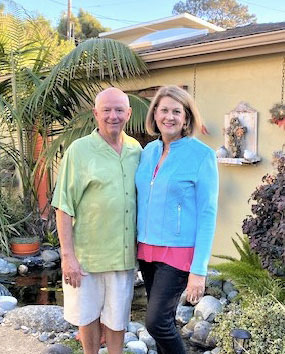
“We are both so grateful for our SDSU DNA, and we want to continue to support efforts toward growing a great place for academics and life.”
-Rebecca Long
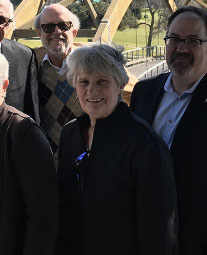
Diane L. Borden, Ph.D.
Diane L. Borden, Ph.D., director emerita of the School of Journalism & Media Studies at San Diego State University, has established an endowed fellowship for graduate students in the School of JMS.
Read more of her story
“As a former newspaper journalist and a scholar in media law and history, I have always believed that the role of the Fourth Estate in society is profoundly important,” Dr. Borden said. “Never has that been more true than now.”
“My hope is that this endowed graduate fellowship will give its recipients the opportunity to examine the centrality of a free press to a healthy democracy—whether the platform is print, broadcast, or digital,” she added.
During her tenure at SDSU, Dr. Borden taught mass communication law and theory, as well as courses in journalism at both the graduate and undergraduate levels. She holds a B.A. in technical journalism from Colorado State University, an M.A. in communication from Stanford University, and a Ph.D. in communications from the University of Washington in Seattle.
She came to academe after a lengthy career in professional journalism, including a 10-year tenure with Gannett Co. Inc., during which time she worked as an editor and publisher in a variety of media markets. Dr. Borden’s research specialty focuses on freedom of speech and freedom of the press, in particular as they intersect with gender.
“This fellowship will provide invaluable support for generations of graduate students who want to study mass media and who are interested in careers in all media fields,” said Peggy Shannon, dean of the College of Professional Studies and Fine Arts. “The College is very appreciative of Dr. Borden’s commitment and dedication to higher education and to the University.”
Wayne and Mary Beitler Leutloff
The Aerospace Engineering Department in the College of Engineering at SDSDU is ready for liftoff with an estate gift from Wayne and Mary Beitler Leutloff.
See their story
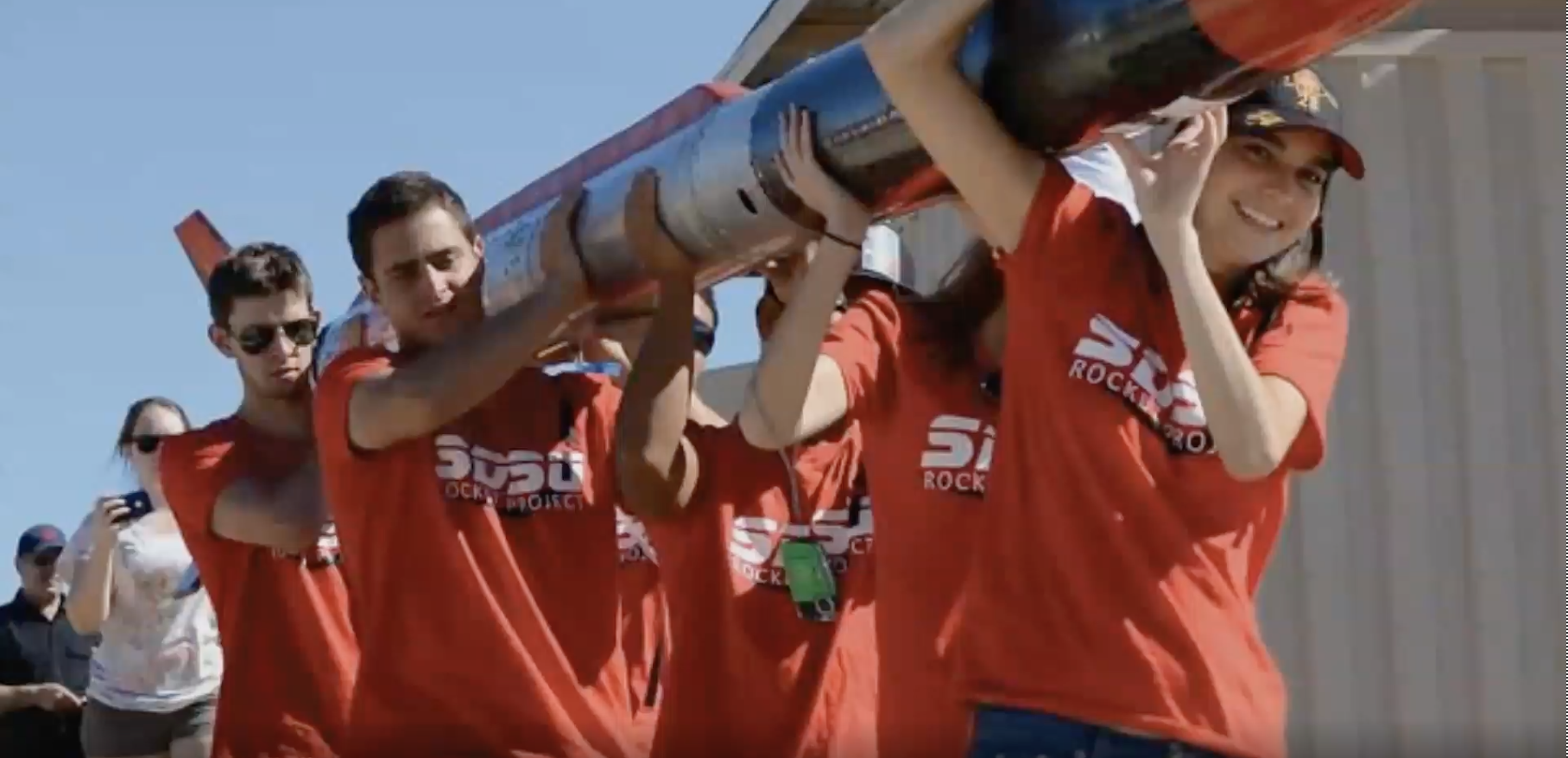
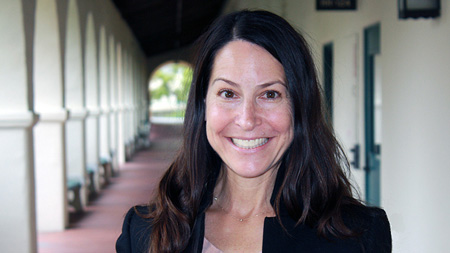
Alana Nicastro (’93, ’97), Ed.D.
For decades, Dr. Alana Nicastro (’93, ’97), Ed.D., has made an impact on students, including Billy Fallon (’03, ’05). See why she left a lasting impression on him and how she will continue to impact Aztecs forever.
Read more of her story
“She just folded her arms and stood there,” Fallon recalled. “It was a long, uncomfortable silence. I thought she was crazy.”
But as a few students began tentatively volunteering their thoughts, the awkward silence became a serious discussion. Fallon soon came to view the instructor, Alana Nicastro (’93, ’97), Ed.D., as innovative and thought-provoking.
What she had done, he realized, was force students to examine a learning experience from a different perspective. Nicastro had challenged them to take ownership of their learning.
“One of many things I ended up taking away is that unlike professors who will (merely) impart their knowledge, she asks difficult questions and lets you struggle with them for a while,” he explained. “Those kinds of questions are the ones that develop critical thinking and nurture a love for learning and self-discovery that certainly made a big difference in my wanting to pursue a graduate degree.”
Violating Norms
Fallon is now a lecturer in the SDSU College of Professional Studies and Fine Arts School of Communication. He recently invited Nicastro, his former professor and colleague, to address students in his Communication in Professional Settings class.\
Describing herself as a researcher at heart, Nicastro said her passion is helping people build their skills. When asked about her teaching style, she reflected on the questions she would pose on the first day of class that often initially elicited silence from students.
“That is something I would do because I like to violate the social norms,” the professor said. “Then we can study how we make sense of our surroundings.”
As a qualitative researcher, Nicastro prefers ethnographic methods in her approach to teaching. “Ethnography is a way of life for me,” she said. She tries to understand the perspectives of her students before trying to present a curriculum.
“I think very carefully about what content I am going to share or what boundaries I am going to create so students can make sense of the content,” she explained. “Then I think about inspiring them.”
It seems to work. Student reviews of her courses are overwhelmingly positive.
A Generosity of Spirit
For almost two decades, Nicastro taught a variety of courses in the School of Communication. These days, she works for the United States Marine Corps at a center of excellence called the Marine Corps Tactics and Operations Group (MCTOG) where she offers a different perspective on educating personnel.
“I challenge military personnel to analyze their practices and hopefully encourage new ways of thinking and learning,” she said. “A lot of the work I do stems from what I learned in the master’s program in communication here at San Diego State. Our renowned communication faculty prepared me well.”
It is out of an appreciation for that preparation along with a continuing dedication to SDSU communication students that the professor has now formalized a planned gift to the university. The donation will form the Alana Nicastro Endowed Scholarship in Communication in the College of Professional Studies and Fine Arts. The scholarship offers graduate students funding opportunities to present their research at national and international conferences.
The endowment will provide annual scholarships for School of Communication students in perpetuity. Nicastro said her gift is a way to show her appreciation to the university while forever supporting and inspiring its students.
“I thought San Diego State was generous in developing my talents, so it’s the least I can do,” she explained. “I believe teaching is about creating a space for our students to do their best thinking, and I feel that was the gift I received while I attended this university, so I just want to extend the gift to others.”
As an initial skeptic who came to admire Nicastro’s teaching style and appreciate her commitment to students, Fallon said he is not surprised she would find a way to extend her positive influence in the School of Communication.
“She has a generosity of spirit and I think she is outstanding,” he observed. “I am here to tell you that she had an impact in our department, absolutely.”
Now, through her scholarship endowment, Alana Nicastro always will.
There are many ways you, like Alana Nicastro, can extend your support of SDSU and our students into the future. Contact Amy Walling at awalling@sdsu.edu or (619) 508-9255 to find your gift.
Patsy (’69, ’75) and Gerry (’65, ’73) Kirk
“I was going to be an elementary teacher from day one,” she recalled. “You could ask me when I was 10 years old and I would tell you, ‘I’m going to be a teacher.'”
Read more of her story
“It just appealed to me,” she said. So much so, in fact, that she taught elementary school for 39 years.
Patsy’s husband, Gerry (’65, ’73), was similarly driven, but in a different way. His professional goals were influenced by a love of music.
“Since I was a junior in high school, I said, ‘I’m going to be a band director,'” he explained. “That was it; I was just totally focused on what I wanted to do.”
Right out of college Gerry landed a position as a band director and taught music for 37 years. All but five of those years he spent just three miles from SDSU at Helix High School where he was band director instructing a range of music groups including the bagpipe band, the orchestra, the marching band, the cadet band, and music theory.
“It was heaven,” he said. “I used to tell people I loved my job so much I would teach for free and they would say, ‘Don’t tell the administration that.'”
Finding Their Rhythm
Patsy and Gerry met through the Marching Aztecs. She was a freshman twirler and he was a graduate student working to complete a teaching credential.
They lacked a common rhythm at first. While Gerry was launching a teaching career, Patsy was still a student, but over time the pair developed a certain harmony.
They were married after Patsy’s first year of teaching. “So that was a long time,” she said. “Five years off and on—more off than on—but the timing was right.”
That was 48 years ago. After long and gratifying teaching careers, the Kirks are retired and enjoy traveling the world and engaging in new experiences.
Gerry conducts, composes, and arranges for Bonafide Brass, a 12-member trombone ensemble. With more free time, they have both reconnected with SDSU and enjoy attending university events.
A Lasting Impact
Having supported SDSU through various donations, the Kirks recently began discussing ways to make a more personal lasting impact at the university. They considered creating music or education scholarships along with other possibilities, but ultimately decided to fund an endowment providing scholarships to SDSU students in perpetuity.
Having come from San Diego families of modest means, the Kirks both attended local public schools and worked during their SDSU student days to fund their undergraduate educations. Each managed to graduate in four years debt free.
“And that rarely happens anymore,” said Gerry. “Today, kids have to work two or three part-time jobs and go to college, which is really hard.”
“I worked, but I was lucky enough to get some scholarship money,” said Patsy. “We just decided that the most important thing we could do at this point in our lives was to help kids go to school. It’s the right thing to do.”
Creating a Legacy
To set up their endowment, the Kirks enlisted the assistance of SDSU Interim Associate Vice President of Development Mary Darling, who lauded the couple’s vision for their legacy at SDSU. “Patsy and Gerry are not only generous, but forward-thinking in their support for future generations of SDSU students,” she said.
The one stipulation the Kirks made on their scholarships is that recipients come from public schools in San Diego—the city or county. Students from any academic discipline will be eligible.
“By limiting our funding to a particular area, we would not be opening doors to careers and studies that don’t exist now,” Patsy explained. “There is always something new coming along and we will let the university select students in need.”
“We wanted as few constraints as possible,” Gerry said. “But we really wanted to keep it local because we are local.”
Kids Are Their Priority
With so many possibilities to choose from, philanthropic decision-making might seem a daunting task. But for the Kirks, who basically shared the same goal—to become educators—long before they ever met, the choice was simple.
“We don’t have any children,” Patsy said.
“Everybody asks us, ‘Do you have children?'” Gerry continued. “And I say, ‘We have thousands of kids.’
“Kids in college are our top priority. We want to take care of the students.”
Just as they always have.
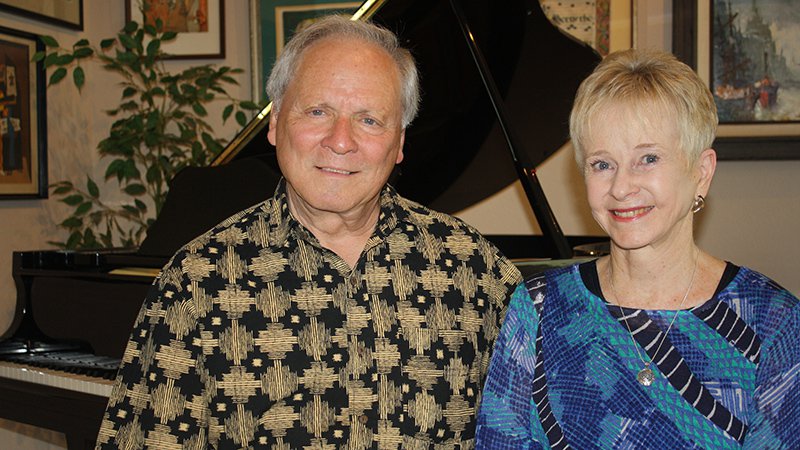
“I thought San Diego State was generous in developing my talents, so it’s the least I can do.”
-Dr. Alana Nicastro (’93, ’97), Ed.D.
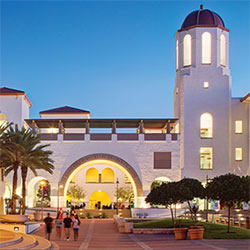
Norah Shultz
Norah Shultz is a newcomer to SDSU. She joined in 2016 as associate vice president for the Division of Academic Engagement and Student Achievement.
Read more of her story
Jeff Shultz was an educational anthropologist and former dean of international programs at Arcadia University. He focused his research and publications on sociolinguistics, multiculturalism, diversity and internationalization in higher education, and was co-author of “The Counselor as Gatekeeper: Social Interaction in Interview,” a seminal book in the field of interactional sociolinguistics.
“Jeff was student-centered. He was deeply involved in social justice and worked to promote multiculturalism at Arcadia, where he was recognized as a professor emeritus,” Shultz said. “I know that creating the Jeff Shultz Endowed Scholarship is a good way to honor him.”
Bob Puccini
Bob Puccini’s parents were concerned when San Diego State University accepted his application to enroll in 1964. He would be the first in the family to attend college, and his mother worried that education would fill his head with dreams he could never realize.
Read more of his story
Now in its 21st year, his company manages $40 million in operations and several million dollars in design projects each year, creating restaurants, hotels and resorts throughout the United States and around the globe.
Henry Janssen’s influence
Puccini started his freshman year at SDSU as a pre-med major, but quickly realized the sciences didn’t suit him. Switching to economics and political science, he found a mentor in professor Henry Janssen. Puccini and his friend, David Johns, shared dinners and political discourse with Janssen, a university legend who taught political science for more than 35 years.
“He was as much a philosopher as he was a political scientist,” Puccini recalled. “Henry saw the world on a higher plane than most other people.”
Puccini’s gifts to SDSU honor Janssen, a former adviser to several campus honor societies, and support students in the Susan and Stephen Weber Honors College.
“Bob is a great example of what young people can achieve with an SDSU education,” said Mary Ruth Carleton, vice president for University Relations and Development. “We appreciate his support of the honors college, which mentors high-achieving students to reach and exceed their potential.”
Industry mentors
Puccini joined the Peace Corps after graduating in 1968. He spent a year in Brazil and then became a tank commander for the U.S. Army, stationed at Fort Knox. After those worldly experiences, further classroom education seemed irrelevant.
Instead of returning to school, he became manager of the Bali Hai restaurant in San Diego and went on to hold a series of increasingly responsible positions in the hospitality field. His mentors include industry giants George Millay, founder of Sea World, and Larry Cano, the pioneer behind the El Torito restaurant chain. Puccini became vice president of Cano’s company when conglomerate W.R. Grace acquired it in 1978. He was only 30.
“Larry encouraged me to go out on my own,” Puccini said. “He bet that I could open five restaurants in 12 months, and that’s what got me started. Ultimately, I ended up in San Francisco, met Bill Kimpton, and became vice president of restaurant operations for his hotels and then a partner in the first boutique chain in the country.”
Putting on a show
Puccini worked for Kimpton Hotels until 1996, when he formed Puccini Group with Kimpton as his partner. With hundreds of projects under his belt, he now approaches the creation of each new restaurant as a director might stage a play.
“You’re putting on a show with a set, music, lighting and costumes,” Puccini said. “If you do it correctly—if you over-deliver on the promise— it’s an emotionally satisfying experience. Michelin restaurants are more about technique than great food, and sometimes the experience is not as enjoyable as at a normal first-class restaurant.”
Not that Puccini doesn’t value great food and the variety of dishes he has sampled in his travels. His current project for the Sheraton Metechi Palace Hotel—frequent haunt of Russian leader Joseph Stalin—takes him to Tbilisi, Georgia, which is, coincidentally, the center of the SDSU Georgia program.
“Visiting a city as a tourist is much different from going as an entrepreneur,” Puccini said. “If your project is popular, you become a local celebrity.”
And his mom would have been fine with that.
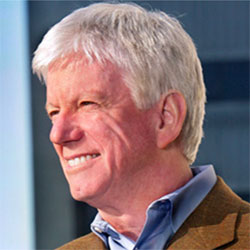
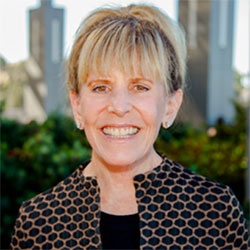
Debra Greenfield (’71)
Before San Diego was the thriving metropolis it is today, Debra Greenfield (’71) and her colleagues imagined its potential. They saw an inadequate public transportation system and envisioned the trolley and the Coaster. They saw land ripe for development and imagined smart, planned growth.
Read more of her story
“I enjoyed a wonderful career, and it all began with my experiences and relationships at San Diego State University,” Greenfield said.
Recently, Greenfield created the Debra A. Greenfield Endowed Scholarship for Public Affairs and the Debra A. Greenfield School of Public Affairs Endowed Internship Scholarship.
“Like SDSU, Debra has played an important role in the development of San Diego,” said Mary Ruth Carleton, vice president for University Relations and Development. “We are so grateful for her support of the region’s future leaders.”
From pre-med to politics
While she started at SDSU with a pre-med focus, Greenfield soon found her interests shifting to political science and government.
She switched her major to public administration and secured an internship in the Chula Vista city manager’s office where she said they allowed her to take on “meaningful and responsible projects.”
Law school followed Greenfield’s graduation from SDSU, as did another career-making internship— this time working with County Supervisor Jack Walsh on an open space plan for San Diego’s unincorporated areas. By the time Greenfield passed the bar exam, she was well-versed in the complexities of regional government.
After a short stint in the Vista city attorney’s office, Greenfield became general counsel and director of legislative affairs at the association that would morph into SANDAG. She had a part in developing the Automated Regional Justice Information System (ARJIS), a national model; working with the Navy to replenish sand on local beaches; and establishing the San Dieguito River Park.
“We took some really big leaps forward in terms of transforming San Diego into a more recognized urban area,” Greenfield said. “As we were coping with the development of the region, we worked to preserve San Diego’s identity with a viable growth management plan.”
Providing opportunities
During her years with SANDAG, Greenfield also preserved ties with SDSU. She was an instructor in land use and environmental law and a mentor to many SDSU interns.
Those ties have only strengthened during her retirement. Greenfield is a member of the Public Affairs Task Force for the College of Professional Studies and Fine Arts, which acts as liaison between the university and the public sector.
She also trains law school interns in San Diego to work with families establishing legal guardianships for children. In 2015, the San Diego Volunteer Lawyer Program recognized Greenfield as Pro Bono Attorney of the Year. This work—combined with her gift to SDSU—is Greenfield’s way of ensuring that future generations benefit from the kinds of opportunities she received throughout her education.
“Students majoring in public administration and city planning have such worthy goals,” Greenfield said. “They want to help their communities. It would be a shame if lack of financial resources prevented these students from pursuing their dreams or taking unpaid internships. I want to give current students the opportunity to have the kind of rewarding career that I enjoyed.”
Joyce Gattas
Joyce Gattas is one of SDSU’s most generous donors among faculty and staff. She has served as dean of the College of Professional Studies and Fine Arts (PSFA) for nearly three decades after several years in Faculty Advancement.
Read more of her story
“I love this university. I’ve devoted my life to it, and I see the value of the education students get at SDSU,” Gattas said. “I want to provide them with those extraordinary kinds of experiences that add value to their education and their own growth.”
As dean, Gattas has connected SDSU to the community through her involvement with San Diego institutions. She has served on numerous boards and committees, including the San Diego Public Library Foundation Board of Trustees, the San Diego Commission for Arts and Culture Advocacy Committee, the Balboa Park Conservancy and the San Diego Women’s Foundation.
She has also worked with alumni and friends of SDSU donors to raise scholarship support for students whose professional internships are not funded.
“I believe one of the pillars of PSFA is internships,” she said. “They really get to the core of these professional disciplines.”

“I want to give current students the opportunity to have the kind of rewarding career that I enjoyed.”
-Debra Greenfield (’71)
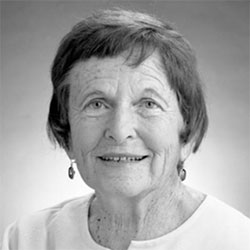
Sue Earnest
During her time on faculty at SDSU, Sue Earnest worked tirelessly to help make the University’s highly ranked School of Speech, Language and Hearing Sciences what it is today. Thanks to her son’s memorial gift, her impact will live on through students who benefit from a scholarship in her name.
Read more of her story
“Dr. Sue,” as she came to be known, co-founded a community speech and hearing clinic and the program that evolved into San Diego State University’s highly ranked School of Speech, Language and Hearing Sciences (SLHS) of today. The planned gift from Les Earnest will support a major endowment in her name to provide scholarships for SLHS master’s students, many of whom remain in San Diego after completing their training.
Les Earnest is a retired and acclaimed computer scientist now living in Los Altos Hills. He attended SDSU for one year in 1949, studying engineering, before returning to Cal Tech, where he had started his education.
Among many noteworthy points in his biography are his integral roles in the founding of the Stanford Artificial Intelligence Laboratory, and, in 1961, as designer of the first spell-checker. In 1981, he was founding director and president of Imagen Corp., which made the first desktop publishing systems using laser printers.
“I think San Diego State is a very important institution,” Les says, “and I particularly want to honor my mom for her good work both there and on me. I owe a great deal to her, needless to say.”
Rigorous Master’s Program
The scholarship endowment will support graduate students in the master’s program for careers in speech-language pathology, both as independent and collaborative team clinicians. Marked by a commitment to theoretical and research components, the speech-language pathology Master of Arts program was ranked No. 24 in the nation and first in California by U.S. News & World Report.
Housed in the College of Health and Human Services, the five-semester M.A. program enrolls only about 38 students each fall out of more than 400 applicants, says Tracy Love, director and professor of SLHS. Intense academic and clinical training gives students little time for jobs to support their training, she notes.
Steven Hooker, dean of the College of Health and Human Services, says: “Les Earnest’s generous planned gift to the School of Speech, Language and Hearing Sciences will contribute to the education and clinical training of master’s students for decades to come. This will stand as a wonderful tribute to his mother, whose 26 years teaching at this campus are still being felt in our speech-language pathology classrooms and around the community.”
A survey of alumni in 2017 indicated more than six of every 10 speech-language pathology graduates remain in San Diego County, drawing upon what they have learned to provide services in public schools, hospitals and other medical fields, and private and nonprofit organizations.
Sue Earnest moved to San Diego from North Dakota with her family at age 4. She earned her bachelor’s degree from the College of Education in 1928 and a master’s in 1938. She spent many years teaching in San Diego elementary schools and at Memorial Junior High.
Her academic career started as assistant professor in the English and psychology departments. She moved into the Speech Arts Department the following year, a time when speech testing and public speaking were treated as priorities for all students. She co-founded speech pathology and audiology as a separate department and, in 1952, the outpatient clinic that has provided speech and language and audiology services to the campus and community for 66 years.
It wasn’t all academics for Dr. Sue (the Ph.D. was from the University of Southern California). Sue was president of the Alumni Association in 1940, when she reportedly launched an unsuccessful campaign to fund a student union. She is credited with tracking down more than 700 “lost” alumni, and organized the first pre-1950s class reunion. She also was active with the Mortar Board honor society.
Sue retired in 1973 and remained close to the university as a generous donor until her death in 2007 at age 100.
Ryan Donovan
Ryan Donovan understands the importance of athletic scholarships. Before he was head coach for the SDSU men’s golf team, Donovan played for the Aztecs. He was recruited on scholarship, but some of his teammates weren’t so lucky.
Read more of his story
“We want to be competing against the best programs in the country, to say we had a piece of it,” said Donovan. “Scholarships are an important part of winning national championships.”
With Donovan as coach, the Aztecs have advanced to the NCAA regionals every season with an active streak of 20 straight postseason bids. Two of his players— J.J. Spaun and Xander Schauffele—are currently on the PGA Tour.
Donovan is the type of coach who knows his players well and keeps in touch with them long after they leave SDSU. He attends their weddings, writes them professional references and even hires some of them to be his assistant coaches.
“The most important thing to remember is where you came from and the opportunities you were given,” Donovan said. “If you can return the favor by giving back, that’s the best.”

“The most important thing to remember is where you came from and the opportunities you were given. If you can return the favor by giving back, that’s the best.”
-Ryan Donovan
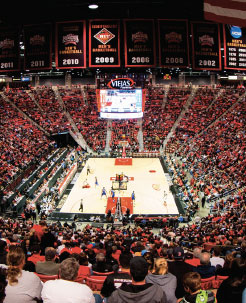
Dan and Bobbie Plough
SDSU Alumni Dan and Bobbie Plough have been longtime Aztec supporters. But, after their son met an SDSU sports icon, they decided to increase their support.
Read more of their story
One day Tim, a point guard for the freshman boys’ basketball team at Ramona High School, was at a preseason camp when Steve Fisher, then head coach of SDSU men’s basketball, paid a visit. Tim came home “just beaming about meeting Mr. Fisher,” says Dan ’75, ’80. They decided to attend a game, were immediately hooked and have been season ticket holders for the past 18 years.
Coming back to campus for basketball made the Ploughs realize how much they missed SDSU. “We both said we’re sorry we didn’t do this earlier,” says Bobbie ’76, ’91, ’11, who also returned for a doctoral degree in education. “It’s like being home.” They have become generous donors as a result, with consistent gifts to the athletics program and the College of Education.
“Dan and Bobbie are the quintessential SDSU alumni—loyal, generous and committed to the university,” says Y. Barry Chung, dean of the College of Education. “They understand that San Diego’s future depends on SDSU’s ability to educate and serve the community with the help of our donors.”
For Dan, SDSU was “the only university that I had in mind” after graduating from tiny Mountain Empire High School in Pine Valley. For Bobbie, it was an abrupt change of plans—a departure from the disappointing lack of diversity at a private university in the Pacific Northwest.
Although they attended SDSU together as undergraduates, the Ploughs met off-campus at La Mesa’s Grossmont High as supervision aides—”narcs,” as they freely admit.
After graduating, “I felt confident in my ability to go into the classroom and be an effective teacher,” says Bobbie, whose career path took her from middle and high schools to administrative positions in K-12 education and superintendent jobs in Riverside, Sacramento and Santa Clara counties.
Dan, a math teacher after SDSU, went on to administrative positions in the Warner Unified School District, Grossmont Union High School District and Calexico, also serving on the Ramona Unified School District board for seven years. Both are retired from positions at CSU East Bay.
He joined the Aztec Mentor Program, which connects juniors, seniors and graduate students with alumni who share their expertise and strengthen the students’ career development. It’s not just a one-to-one benefit, Dan notes. “To me, there is a true connection between San Diego State and San Diego County.” Bobbie plans to become a mentor as well.
The Ploughs’ gifts to the university have been made with no specifications as to how they should be used, even in the College of Education. “We do it because we want to make sure that the program does the best that it can,” says Dan.
Bill ’76 and Karen Brack
Bill Brack, ’76, a finance major, and his wife, Karen, began exploring the idea of a planned gift to SDSU when they were updating their estate plans.
Read more of their story
Karen is a loyal Louisiana State University alumna, and the couple has divided their giving between the two universities.
“We wanted to give back to our alma maters,” Bill said. “We both feel that our college education gave us the opportunity to have fulfilling careers, and we want to create the same educational opportunity for other deserving students.”
Leaving a legacy
What Jones likes to emphasize is that anyone can leave a legacy.
“By leaving a bequest or gift to SDSU through your estate plan,” she said, “you start a legacy and also send a message that you value education.”
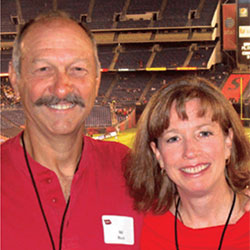
“By leaving a bequest or gift to SDSU through your estate plan,” she said, “you start a legacy and also send a message that you value education.”
-Karen Brack
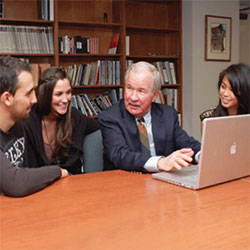
Glen Broom
Glen Broom forever changed the face of public relations during his career as a professor at San Diego State University. He literally wrote the book—the quintessential book—on public relations.
Read more of his story
Now an emeritus professor, Broom, together with some of his former students, is broadening SDSU’s legacy of excellence in the field of public relations.
They have made gifts to establish the Glen M. Broom Center for Professional Development in Public Relations in SDSU’s School of Journalism and Media Studies.
“Nothing else like this center exists in the nation,” said Joyce Gattas, dean of the College of Professional Studies and Fine Arts. “It will be a national model for excellence, just like Glen Broom; and we are so fortunate to be able to continue his tradition.”
Aztec faculty and staff are a pillar of The Campaign for SDSU. As a group, they have contributed about 10 percent of the $400 million raised so far during the campaign, and their support is a clear signal that SDSU’s work is worthy of investment.
In the Broom Center, staff will work with the guidance of journalism and media studies faculty members to administer an internship program for public relations students, offer student advising and career development, provide training programs for working professionals, and support research activities for faculty and graduate students.
Key founding donors of the Glen M. Broom Center include: Scott Allison (Allison + Partners), Gordon Broom (HeplerBroom LLC), Diane Gage Lofgren (Kaiser Foundation Health Plan, Inc.), Scott Pansky (Allison + Partners), MaryLee Sachs (Changing MO LLC), Larry Thomas (retired, The Irvine Company) and Bill Trumpfheller (Nuffer, Smith, Tucker ).
Diane Denkler
One day of shorthand homework was enough to convince Diane Denkler that a career as secretary or teacher would never make her happy.
Read more of her story
In 1961, she became the first woman to graduate with an engineering degree from San Diego State, choosing civil engineering/structural design as her major. It was an unlikely pick for a woman at the time.
Always realistic, Denkler expected resistance from professors and fellow students, but she hadn’t anticipated practical problems like conducting field surveys dressed in the skirts that all coeds wore.
“I would trudge down the mountain behind campus with my tripod over my shoulder and walk through a tunnel under the four-lane freeway. Well, that got old, and I soon found a better solution. I drove to the site and changed into slacks in my car.”
Denkler developed a strong attachment to State, and the feeling was mutual. She became freshman class secretary, president of Alpha Phi and a member of the homecoming court. Engineering students voted her Miss Aztec Engineer and built a float built exclusively for her appearance in the 1961 Homecoming Parade.
As graduation approached, career placement staff—perhaps concerned that the world was not ready for a woman engineer—arranged interviews for Denkler with four major corporations. All four offered her positions, and she joined Pacific Telephone & Telegraph, now PacBell, as a chief engineer.
Again, she faced opposition from some, but many recognized her ability. In 24 years at PacBell, Denkler held 27 positions, and was the first women to occupy most of them. Subsequent careers in in- surance and marketing deepened her experience in ways that have made her a valuable mentor for young women.
Now retired, Denkler lives with her husband, Neal, in Palm Desert, where she serves on the board of the College of the Desert Foundation and the McCallum Theatre auxiliary, and finds time for golf, Mah Jonng and travel.
Active in The Campaign for SDSU, the Denklers have made a planned gift and are members of the National Campaign Commit- tee.
“I realize my education at SDSU opened doors to opportunities in both business and public affairs and now in retirement,” Denkler said. “During a recent tour of campus and the engineering facilities, I was awestruck by the sophisticated and far-reaching educational opportunities available to our students. I am grateful to be able to give back and say thank you.”
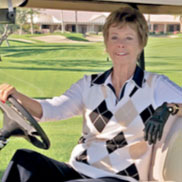
“During a recent tour of campus and the engineering facilities, I was awestruck by the sophisticated and far-reaching educational opportunities available to our students. I am grateful to be able to give back and say thank you.”
-Diane Denkler
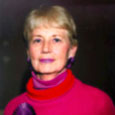
Arline Fisch
Arline Fisch’s jewelry art is not for the faint-hearted. Her dramatic silver collars and intricate filigree bibs draw inspiration from ornamental jewelry worn by ancient Greek and Egyptian royalty.
Read more of her story
Fisch’s theatrical sensibilities influenced not only the craft of jewelry-making in the United States, but also the work of generations of San Diego State University students. She was hired in 1961 to create a jewelry and metalsmithing program in SDSU’s School of Art and Design (then known as the School of Art, Design and Art History).
Universities across the country established similar programs at the time, but many didn’t survive. SDSU’s program thrived and, under Fisch’s leadership, added a master of fine arts degree. The MFA in jewelry and metalsmithing is still among the leading programs of its kind in the nation.
Fisch retired in 2000 but her legacy continues through former students who have become artists, gallery owners and university professors. She recently established an endow- ment for future Aztecs with ambi- tions to follow in her footsteps. The Arline Fisch Jewelry and Metalsmithing Endowed Scholarship will support students pursuing a master of fine arts degree in the program. “SDSU was my life for 40 years,” she said. “It was a good place for me to have the freedom to teach and be an artist at the same time.”
Fisch was the first artist to combine jewelry-making and weaving into a unique art form. She learned metalsmithing from the accomplished silversmith, Arthur Pulos, and worked in his studio during her graduate studies at the University of Illinois. Later, as a young teacher at Skid- more College, Fisch taught classes in weaving.
The idea of marrying two very different crafts first occurred to Fisch during a visit to Central and South America, where she saw pre-Columbian textiles embellished with gold and metallic pieces. But it would be another decade before the concept came to fruition in her collection of woven gold items. That collection was shown in London, Vienna and California.
The appeal of traditional artifacts—such as Viking jewelry and Mongolian hats—grew stronger as Fisch continued to travel internationally. She received four Fulbright grants, allowing her to study in Denmark, and teach in Uruguay and Austria. Fisch also became a board member of the World Craft Council, an organization of UNESCO.
SDSU students have reaped the benefits of Fisch’s global network; she hosted dozens of internationally recognized artists who visited San Diego to lecture and work with her students. “It’s important for students to be taught by professionally active artists,” she said.
Throughout her teaching career, Fisch continued to develop the textile techniques that brought her international fame. In 2006, she was commissioned by the Racine Art Museum in Wisconsin to create an exhibition for its five street windows. The result was “Sea Creatures,” a riotously colorful collection of jellyfish knit from thin wire. Later, she added coral-like shapes, and the exhibition toured for nearly four years before being purchased by the Mingei International Museum in San Diego’s Balboa Park.
Vince Meades
It all started with a box of movie sheet music at a garage sale. Coupled with a childhood love of movies and the desire to start a collection that that would one day be a gift that would benefit scholars and researchers, and you have the origins of the Vince Meades Popular American Sheet Music Collection.
Read more of his story
All genres and themes are represented within the collection, with the sheet music portion of the collection dating back to the end of the Civil War. While popular music from movies is the strongest category within the collection, it also includes music from television and radio, as well as music from Broadway musicals.
Not only is the collection a valuable resource for researching the history and development of American musical theatre and 20th century musical films; it also serves as a record of American history.
In addition to providing a reflection of common emotions, values, and experiences through popular song lyrics, the sheet music also features cover artwork that is illustrative of its respective time period.
The Vince Meades Popular American Sheet Music Collection offers a sampling of the work created during the Roaring Twenties by many legendary writers and artists—which includes numerous beloved jazz and musical theatre standards.
Currently, a portion of this collection is displayed in the 24/7 exhibit case to focus on Broadway’s busiest decade and the legacy of late 1920s musicals.
Collaborating with Special Collections and Arts Alive, the School of Theatre, Television, and Film and the entire production team of The Drowsy Chaperone are thrilled to highlight this important collection!
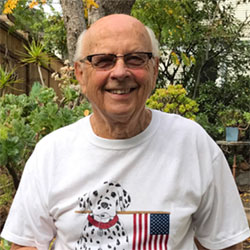
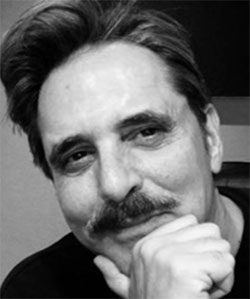
Stephen Reaves
After a successful career as a creative director for some of Hollywood’s biggest names, alumnus Stephen Reaves found his true vocation.
Read more of his story
Enthusiasm for mentoring is clear in Reaves’ voice when he outlines the advice he often gives students. “Don’t look over your shoulder for the latest, hottest thing,” he counsels them. “Why don’t you create the latest, hottest thing? Bring your true self into your design—your beliefs, your persuasion, your experiences.”
Reaves’ commitment to the next generation of graphic artists found new expression recently when he decided to make a planned gift to San Diego State University. His gift will support scholarships for graphic arts students in the School of Art and Design, where he earned a bachelor’s degree in 1978 and a master’s in 1987.
Reaves transitioned from advertising into the entertainment industry in the 1990s as art director and designer for more than a dozen film campaigns, including those for “The Shawshank Redemption,” “Apollo 13,” “Fearless” and “The Age of Innocence.”
He rose to vice president of creative for Intralink Film and Graphics and New Line Cinema. At that time, computer graphics began to replace illustration in the design process, and the entertainment industry was among the first to embrace the change.
Drawn by Reaves’ reputation, FIDM approached him to write a new graphic arts curriculum for its students. He also began to teach and was immediately hooked. He has generated internships and employment opportunities for students and developed industry partnerships for the school.
Despite his broad experience, Reaves said he is still learning. “Art, by nature, is investigative. You never know enough. My whole perception of graphic design has changed through my work in entertainment and fashion. It’s not about selling a product; it’s about generating an attitude. Graphic design creates an emotional connection that can be very moving.”
Anne Rosser
For SDSU class of 1961 alumna Anne Rosser, a forty-year career dedicated to high school education began at the age of seven.
Read more of her story
Being a resident of San Diego, Anne’s ties to the community led her to apply to San Diego State University. That, and her parents offered her a deal she could not refuse. If Anne were to attend SDSU, her parents would fund a study abroad tour. With local pride and a prospective opportunity for education abroad, Anne was accepted into SDSU as a Physical Education major with a minor in Social Science. Anne chose to live at home and commute to school, but that did not stop her from becoming a highly involved student.
Shortly after arriving at San Diego State, Anne joined the Alpha Gamma Delta sorority. Because activities in the sorority happened on campus, Anne was provided with a deep sense of belonging and she quickly became integrated into campus culture.
Another way in which Anne became strongly connected to SDSU was through her promised study abroad tour in 1960. Anne’s trip comprised of 40 students, faculty, and staff travelled to twelve countries across Europe in 72 days. Anne’s time abroad, as her mother told her, was an “education in and of itself.”
After graduating, Anne went on to teach the youth of San Diego with a starter year at Oceanside High School, twenty-nine years at Madison High School, and finally, retiring from Mission Bay High School. As an alumna, Anne not only devoted herself to secondary education, she also continued being an integral part of SDSU. Till this day, Anne continues to mentor students in the SDSU School of Teacher Education as they prepare to graduate and teach future generations of students. For these reasons, Anne designated a portion of her estate to support student scholarships and faculty research and development within the College of Arts and Letters.
Anne’s passion for travel never ended with her first San Diego State trip in 1960. Her appreciation for the Humanities led her to become involved with the Confucius Institute. Anne visited different parts of China with other faculty and staff from SDSU including former Dean Paul Wong. Another trip with Dean Wong, called the Library Tour, took place in Vietnam. Finally, Anne even accompanied the late Ambassador Charles W. Hostler to the Balkan countries of Albania Macedonia, Kosovo and Montenegro.
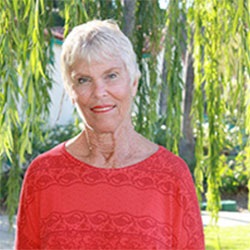

Paul Pfaff
When Paul Pfaff was out of earshot, his students called him god. The professor’s riveting voice, keen wit and rapier-like tongue both impressed and slightly intimidated students on the campus of San Diego State College in the 1940s.
Read more of his story
Richardson was the first recipient of the Paul Pfaff Memorial Scholarship, which enabled her to return to State and complete a master’s degree in 1970. After graduation, Richardson went on to create and teach the first program for aphasic children at Rowan Elementary School in the San Diego City School District.
In honor of Pfaff’s legacy, she has made a contribution to the scholarship for high achieving graduate students or upper division undergraduates in the School of Speech, Language and Hearing Sciences.
The first San Diego State professor to teach in the field of speech pathology, Pfaff earned his undergraduate degree at State and his doctorate at the University of Southern California under Lee Edward Travis, a pioneering speech pathologist and clinical psychologist.
Pfaff joined the San Diego State faculty in 1932, served several times as chair of the speech department and enhanced its reputation by hiring some of the most illustrious academics in the field, including the oral interpreter C.C. Cunningham.
“These areas of study would not have evolved as broadly quickly or as comprehensively as they did without Paul,” Richardson said. “He brought in quality people to lay the foundation of the school.”
Mary Sample Willette
Mary Sample Willette was a teenager when she met Meral Korzay, a Turkish student studying in San Diego through a Rotary exchange program. The two have maintained a lifelong friendship while living on different continents.
Read more of her story
According to Mary, her lifelong friendship with Meral, as well as her parent’s devotion to their business, motivated her to create a legacy within the School of Hospitality and Tourism Management (HTM) at San Diego State. Her significant planned gift to the university created the William Sample and Fern Sample Stanford Memorial Endowment to Enhance International Exchange, a source of funding that will exist in perpetuity.
“I felt it was important to honor my parents while also encouraging students to study abroad,” Mary said. “Through my own experiences, I’ve learned that international travel helps to expand your perspective and how you view the world.”
The Willette endowment will eventually provide a minimum of $60,000 annually in support of international study for HTM students and for international stu- dents interested in studying the field at SDSU. Honoring Mary’s strong connection to Meral, preference will be given to those who study abroad at Bogazici University. A portion of the funding will also support HTM faculty participation in foreign exchange programs and activities.
HTM Director Carl Winston said Mary’s contribution aligns perfectly with the vision of SDSU’s School of Hospitality and Tourism Management.
“SDSU has one of the largest study abroad programs in the country, and we’re consistently ranked with the best,” Winston said. “Global orientation is a component of all SDSU schools and programs, especially within the tourism specialty.
“Our new emphasis in sustainable tourism requires a semester abroad. Mary’s gift will make this possible for many students, including those who couldn’t otherwise afford it. She is helping us offer invaluable hands-on experience to support our students’ personal growth, as well as their careers, and we are grateful for her vision and generosity.”
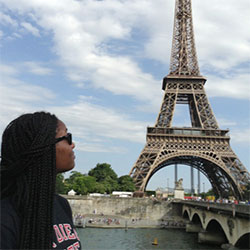
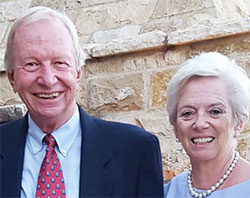
John Wills
John Wills became a mentor even before he graduated from San Diego State University in 1965. His stepfather was a fellow student, and Wills helped him adjust to school life after a long career in the military.
Read more of his story
These days, close to retirement himself, Wills still mentors students and reconnects with other Aztecs through the Los Angeles Regional Council, one of seven regional alumni groups whose members support SDSU through fundraising, network building and investing in student success.
In 2012, Wills, along with others, assisted chair Gary Weiss (’79) to form the LA Regional Council. The council recruits alumni who are leaders in the entertainment, finance, aerospace and other industries, and who recognize the need to give back to their alma mater.
In addition to other initiatives it supports, the LA Council was the first regional council to offer annual scholarships. These scholarships support SDSU students from the Los Angeles area.
Wills’ involvement has grown since then. He joined the National Leadership Council in 2016 and for the second year, he is one of several alumni organizing an annual Fall Forum, bringing regional council members together from all over the country to get acquainted and share best practices.
Wills first returned to campus to help students with career development and discovered an affinity for the work. “I started to get interested in helping the students get where they wanted to go,” he said. “In the ‘60s and ‘70s, most of us had to figure it out on our own.”
Wills did figure it out with a 30-year career as president and CEO of FLI Consulting, a company he founded to help Fortune 500 companies prepare their employees to leverage technology for greater efficiency and productivity.
The success of his company put Wills in a position to give back to SDSU. He and his wife, Jane, have created The Wills Family Trust Endowed Scholarship to assist students, primarily in the Fowler College of Business. As a regional council leader, he also encourages fellow alumni to join him in supporting SDSU.
“I try to explain to people who’ve had long, successful careers that it’s important to help because we all got a great start at SDSU, and that since we graduated, state funding to higher education has fallen so drastically,” he said. “For alumni from other Los Angeles area universities, giving back has been standard practice for decades.”
Donald Grey Wilson
Donald Grey Wilson was twice named “Most Influential Instructor” by San Diego State University students in the 1980s. Though he retired in 1991, he has been a mentor to electrical engineering students ever since.
Read more of his story
“Although Dr. Wilson had long since retired when I became dean of engineering, he remained engaged with the college, providing a unique insight and perspective that only comes from a long career as an academic,” said David Hayhurst, dean of the College of Engineering.
“He remained committed to supporting exceptional students in electrical engineering. He will certainly be missed by me.”
Devotion to SDSU
Wilson received his his undergraduate degree from Rensselaer Polytechnic Institute, his master’s and doctoral degrees at Harvard, and headed the University of Kansas electrical engineering department before teaching at San Diego State. But something about SDSU really resonated with him.
In a 2009 interview, Wilson told SDSU NewsCenter, “My San Diego State experience was very rewarding, and making my contribution was a way to express my appreciation.”
After retiring, Wilson created his namesake scholarship fund for electrical engineering students, a fund that has helped many students throughout the last 20 years.
Wilson spent 30-plus years as an informal liaison between SDSU’s Department of Electrical and Computer Engineering and the San Diego section of the Institute of Electrical and Electronic Engineers, the nation’s largest professional society. He was active in the institute and was always looking for ways to make meaningful connections between students and professionals in the industry.
Lifelong commitment to electrical engineering
Wilson’s career as an electrical engineer began in 1940 with a five-year stint as an instructor at Rensselaer Polytechnic Institute.
Over the next five decades he conducted radar research at the Massachusetts Institute of Technology; chaired the electrical engineering department at the University of Kansas; consulted with the U.S. Naval Ordnance Test Station on the Sidewinder Missile; held leadership positions with General Dynamics, P.R. Mallory and Company, C.C.C. Inc., Continental Resources Minerals Corporation and Tanzi Mergers and Acquisitions before landing as a lecturer at SDSU.
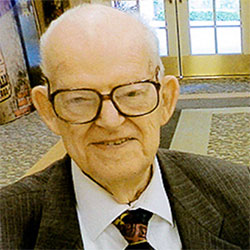
“I try to explain to people who’ve had long, successful careers that it’s important to help because we all got a great start at SDSU, and that since we graduated, state funding to higher education has fallen so drastically.”
-John Wills
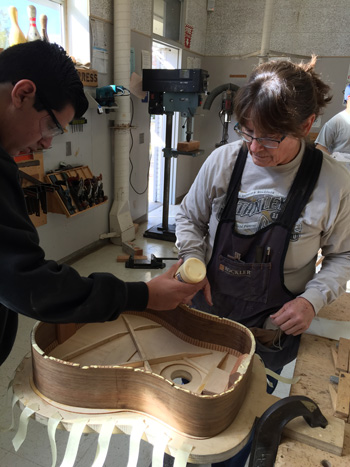
Kathy Worley
For Kathy Worley, her time as a student-athlete at SDSU was a defining moment in her life. Now, she’s ensuring her support for the sport, and school, she loves will continue for years to come.
Read more of her story
Kathy is well-known in San Diego high school softball circles, having guided Mount Miguel High in Spring Valley to three CIF-San Diego Section championship games, including a Division II title. At present, and for the better part of 30 years, Kathy’s place has been in the classroom. She currently serves as the instructor for industrial design at West Hills High in Santee, where she teaches Industrial Technology. Though no longer coaching, she has been recognized for numerous accomplishments in athletics, including: San Diego County Teacher of the Year, Breitbard Hall of Champions Coaching Legends, the California Interscholastic Federation’s Coach of the Year and California Coaches Association’s Athletic Director of the Year.
Thinking about her time at SDSU, Kathy cherishes, “the friendships I made with my teammates on the softball team. It wasn’t about the games, it was about the preparation for the games, the fun we had. The shared hard work to prepare to compete helped us bond.” It was these friendships and her love of the game that inspired her to create the first planned gift for softball at SDSU.
Head Coach Kathy Van Wyk reflects on the impact Kathy’s gift will have on the future of the softball program. “Just the idea of the endowment is huge. It’s the gift that keeps on giving. Those are things that I think are necessary for all of our programs to continue on into the future.”
Kathy’s advice to others is, “take care of yourself, your family, your community and your world.” And it is in this spirit that she has made her planned gift. “There were people before me that really laid the groundwork for me and I hope what we do does the same for those that are playing right now. In turn, you hope those student-athletes see that they need to give back when it’s their time…softball is a game, but you can teach so many values. That’s what I’ve always tried to do, even in the classroom.”
Christine Probett
Professor Christine Probett has spent nearly 40 percent of her life at San Diego State. She says it was an easy decision to leave a gift for the school in her estate.
Read more of her story
Donors who arrange to give to San Diego State University through planned gifts enable us to provide transformative educational opportunities. No matter the size of the gift—through your will, trust, real estate, retirement assets or insurance—you can help to support educational experiences that prepare students to engage in the community through creativity, involvement, leadership and innovation.
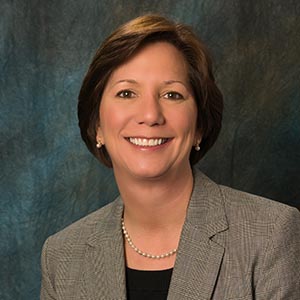
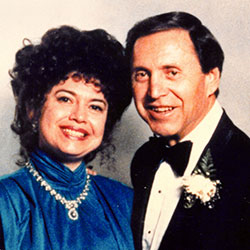
Rabbi Aaron Gold
Rabbi Aaron Gold (1920-2001) was a not just a religious leader, he was a teacher who sought to inspire people to learn more about Judaism. A learned man, Rabbi Gold dedicated his life to the principles of education and outreach. One year, he led four seders, each for a different community group.
Read more of his story
Jeanne chose SDSU because she is deeply impressed by the program and she attends Jewish Studies events regularly. She particularly remembers the Noel Izon’s documentary, “An Open Door: Holocaust Haven in the Philippines,” which focuses on testimony from Holocaust survivors who were given a safe haven in the Philippines. The film also documents how efforts by the Philippine people saved the lives of more than 1,300 Jews as they fled the pogroms in Nazi Germany.
The evening of Jewish music, led by Yale Strom and his group, Hot Pastrami, in October 2009, was also particularly memorable.
Going to these events is always a pleasure, Jeanne says.
Jeanne is also deeply impressed by the program’s director, Professor Risa Levitt Kohn, as well as Dean Norma Bouchard and Janee Shaw, all whom have inspired her.
Throughout his life, Rabbi Aaron Gold was a student and a scholar. Jeanne hopes this gift will honor his memory by supporting and encouraging scholarship in the Jewish Studies program.
Tom Golich ’60 and Donna Bergelis ’60
Although Tom Golich ’60 and Donna Bergelis ’60 attended the same high school in San Bernardino, CA, they met for the very first time as students on the SDSU campus.
Read more of their story
After graduating, Donna stayed home to raise their three daughters, who were all close in age. The couple is proud that all three of their children graduated from college and have successfully entered professional fields. Once they were grown, Donna taught classes in crafting at Mira Costa College. In the realm of crafts, there is little that Donna cannot do. Her skills include making baskets, sewing quilts, and floral design.
Tom earned his BA in General Studies, a degree that included three minors: Geology, Speech Arts, and Economics. These minors served him well as he embarked on a successful and exciting career in the aerospace industry. An early highlight of his career was when he was assigned to a program with Ryan Aeronautical to help build Surveyor, the very first earth object that would land on the surface of the moon. However, his proudest moment came during the years he served on the Solana Beach City Council. During his tenure as mayor, Solana Beach implemented the very first beach and park smoking ban in the continental United States, leading the way for similar legislation at beaches and parks around the country.
Tom and Donna share a passion for the environment and appreciate spending time outdoors. Donna’s love of gardening is an extension of this passion. Tom chairs the President’s Council of the San Elijo Lagoon Conservancy and is also an active volunteer with the San Dieguito River Valley Park.
Tom and Donna have made a planned gift that will support SDSU’s School of Communication and SDSU-affiliated radio station, KPBS. Their gift to the School of Communication was created as an endowment, and will provide scholarship support in perpetuity to students with financial need. They are currently funding a portion of their endowment through a gift of stock so that scholarships will be immediately available for students. When asked what prompted them to make their generous gift, Tom reflected, “SDSU opened up great opportunities for me, This seemed like a good way to give back for all that SDSU has given us.” Donna added, “Lifelong learning is so important. We feel our support of SDSU is really an investment in future generations.”
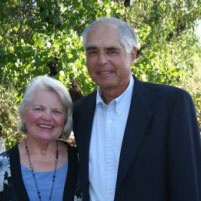
“Lifelong learning is so important. We feel our support of SDSU is really an investment in future generations.”
-Donna Bergelis
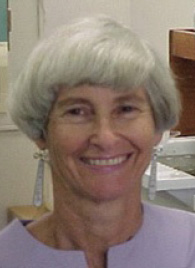
Deborah Dexter
A trailblazing professor with a storied career gives back to the university on multiple fronts, from biology and cultural interchange to the musical theatre she misses so much since leaving.
Read more of her story
The Fulbright took her to Egypt to teach oceanography at the University of Alexandria, while simultaneously doing field work through a National Geographic Society research grant. During more than three decades at SDSU, Dexter also lived and worked in Australia, Panama, Israel, Hong Kong, Thailand, Portugal and elsewhere.
Her appreciation for cultural interchange led her to establish the Deborah M. Dexter Endowed Scholarship for International Students in 2013.
“I feel strongly that every college in the United States should have international students on campus,” she said. “The interaction between American and international students in enlightening for both parties and creates a good impression of our country.”
At SDSU, Dexter taught marine invertebrate biology, biological oceanography, marine ecology and the popular course, Life in the Sea, for non-science majors.
She received six awards for outstanding teaching and multiple research grants from federal agencies such as the Smithsonian Institution, Panama; the U.S. Bureau of Reclamation, Colorado Region; and the U.S. Environmental Protection Agency.
Dexter now lives in Northern California, and misses the SDSU theatre productions. She had been a season ticket-holder.
“Musical theatre is my favorite, and SDSU is the only university to offer a master of fine arts in musical theatre that integrates performance training with academic study,” she said.
This year, she established the Deborah M. Dexter Endowed Scholarship in Musical Theater to support graduate students in this unique and challenging program. Additionally, Dr. Dexter has also established a scholarship for the Biology Department as part of her legacy at SDSU.
Dr. J. E. Lindsay Carter
When Dr. J. E. Lindsay Carter began his tenure at SDSU in 1962 (San Diego State College at the time), we were getting the cream of the crop. A graduate from New Zealand University of Otago, School of Physical Education in 1952; Fulbright Scholarship and Ph.D. at University of Iowa, 1956-59.
Read more of his story
Dr. Carter was involved in the development of new degrees and programs within the Department of Physical Education from 1962- 92. (Physical Education is now part of the School of Exercise and Nutritional Sciences at SDSU.)
Early on, Dr. Carter had a passion for physical activity and the benefits it had on one’s health. In New Zealand, his favorite college experience was an outdoor camping trip to Trotter’s Gorge and his favorite class was Human Anatomy. He wants to encourage students to pursue their passions and he leads by example.
In addition to health and fitness, Dr. Carter consults with international colleagues and is keen on travel and family genealogy. It is no surprise that Lindsay fell in love at the University of Iowa with Lolita Diñoso, Ph.D., a modern dance teacher originally from the Philippines. She received her formal education and developed a solid background in Philippine Folk Dance at the University of the Philippines.
In 1974, Lolita Carter founded the Samahan Philippine Dance Company in San Diego in order to provide Filipino youth the opportunity to gain knowledge and appreciation of their cultural heritage. The dance company is thriving today as the Samahan Filipino American Performing Arts and Education Center. Additionally, Lolita started the dance program at Grossmont Community College in 1964 and taught there until she retired in 1988. Sadly, Lolita passed away in 2011 but left behind a lasting legacy of education to her students and love to her husband of 53 years.
In reflecting on Lolita’s life and his own, Dr. Carter decided he wanted their legacy to include helping students to overcome financial barriers and achieve academic success. In 2013, through a bequest supporting the College of Health and Human Services, he established the J.E. Lindsay Carter Endowed Scholarship in support of graduate students in the School of Exercise and Nutritional Sciences. His gift will allow students facing financial barriers to achieve graduate degrees and set them on a path toward pursuing their own passions and career success.
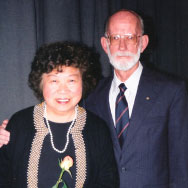
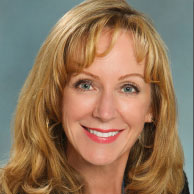
Mary Curran ’82
Mary Curran ’82, a board member of SDSU’s philanthropic auxiliary, the Campanile Foundation, said she was impressed by the university’s “rapid progress in elevating itself” among public research institutions.
Read more of her story
Curran received her MBA from SDSU and joined Union Bank after seven years with Bank of America. Before retiring as executive vice president with Union Bank, Curran also helped arrange a large gift to SDSU from her employer.
Curran’s personal philanthropy is in the form of annual gifts as well as a legacy gift, which will build the university’s endowment, a key to future growth. She supports athletics, the Fowler College of Business Administration and the Guardian Scholars program. The latter provides full support for students who’ve experienced homelessness or have been part of the foster system.
As a TCF board member, Curran takes on the responsibility of advocating for SDSU with friends, other alumni and the San Diego community. In addition to her service as a TCF board member, she has been a mentor and a judge for SDSU’s Venture Challenge competition, organized yearly by what is now the Lavin Entrepreneurship Center.
“The board is an amazingly committed group,” Curran said. “We tell the university’s story, and we’re passionate about it. We’re passionate about the future of SDSU.”
The Dathes
The Dathes are both graduates of SDSU and met through the SDSU Alumni Association. For years they’ve served in various volunteer leadership positions, and are fans of SDSU Athletics. SDSU has played an important role in their educational and social lives. Wanting to give back was a natural desire.
Read more of their story
“There are so many giving options, I was overwhelmed,” explains Matt Dathe. “Life is a moving target and coming up with a specific amount to donate or a way to give was not easy for us as we bought a house, advanced in our careers and started a family.”
The right solution for the Dathes was a planned gift through the Heritage Society.
The Heritage Society honors individuals who have generously named San Diego State as a beneficiary in their estate plans or planned gifts. Since most of these gifts will be realized by San Diego State after the lifetime of the donor, the Heritage Society was created to thank donors in the present for their generous intentions.
“The Heritage Society was a perfect solution for us. It allowed us to give a percentage of our estate, and still have the flexibility to change it to a specific amount as we progress through the years. It has given us peace of mind knowing that we’ve given back in a substantial way,” explained Dathe.
Although there are many ways to give planned gifts and be recognized in the Heritage Society, one of the easiest is through a simple bequest. The donor fills out a form and mails it to the University. The University will send out a letter of intent to be signed. One copy goes to the University and the other to the donor. That’s it. There’s no up front cost, and it’s fully modifiable and revokable, and serves as your commitment to the University.
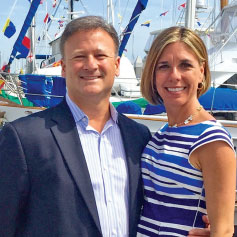
“The Heritage Society was a perfect solution for us. It allowed us to give a percentage of our estate, and still have the flexibility to change it to a specific amount as we progress through the years. It has given us peace of mind knowing that we’ve given back in a substantial way.”
-Matt Dathe
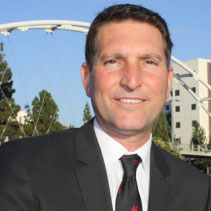
Alan Dulgeroff ’92
Alan Dulgeroff ’92 is a busy guy, especially with regard to his involvement at San Diego State University. He is a member of the university’s Career Services Advisory Board, sits on the College of Engineering’s Electrical Engineering Curriculum Advisory Board, and has served as president of SDSU Alumni.
Read more of his story
Currently director of strategic planning for San Diego Gas and Electric (SDG&E), the 47-year-old Dulgeroff is a lifetime member of the SDSU Alumni Association. He has served on its board the past four years. In the coming year, Dulgeroff intends to make alumni engagement a top priority. “We need to tailor [involvement] to the kinds of things our alumni are passionate about,” he said.
“It’s usually around time, talent and treasure — whether they want to be a mentor, for example, use a particular skill to help the university or its students, or donate to scholarships or other programs. The nature of the engagement must be personalized so that they own it and ultimately stay more engaged.”
One of Dulgeroff’s passions is the Aztec Mentor Program (AMP). He has helped forge a link between AMP and SDG&E. He also helps his company recruit on campus. Dulgeroff estimates approximate-ly 10 percent of SDG&E’s 4,000 or so employees are Aztec alumni.
“That’s a large number of Aztecs we’ve hired and continue to hire every year,” he said. “We’re back on campus every semester recruiting and that has not stopped since I got involved with recruiting about 15 years ago, so we are very active in hiring Aztecs.”
The new president describes himself as someone who likes to innovate, create and take things to the next level. “Every role I take on, I like to move it forward, to extend beyond what’s been done before,” he said.
The father of a 22-month-old son with another baby boy on the way, he places a lot of emphasis on family. “They are my top priority,” he said. “It starts with my family. I view my fellow board members, the university and even the broader alumni group like extended family and that’s why I put so much into my service to SDSU.” It is this mindset which motivated Alan to include SDSU in his estate plan for the support Electrical Engineering programs within the College of Engineering at SDSU.
Richard ’03 and Sharon Fogg
Like most homecomings, this one had implications far beyond the event itself, especially for one San Diego State University alumnus.
Read more of their story
For Fogg, this “homecoming” acknowledges SDSU’s rapidly growing role in the industry, fueled by the quality and quantity of its finance department graduates. To further solidify the partnership, Fogg has recruited young Aztecs to join the FPA board.
“We’re reconnecting the FPA with the heritage of SDSU’s program and ultimately, we’re reconnecting alumni with their alma mater,” said Fogg, president of Pacific Coast Financial Planning Group.
SDSU’s financial planning program was the first in the country to be offered at a fully accredited college of business. Upon completion, students can sit for the Certified Financial Planner (CFP) exam. Fogg joined the program after serving in the Navy. Now, he sits on the advisory board, matches students with mentors and helps find internship opportunities for future financial planners.
“Richard is a person who works extremely hard behind the scenes and doesn’t look for recognition,” said Thomas Warschauer, an SDSU finance professor and director of the financial planning program.
For three years, Fogg has also served on SDSU’s National Leadership Council, whose philanthropic mission is to enhance SDSU’s position as an international leader in teaching, research and service to the global community.
He and his wife, Sharon (’75), are long-time donors. They support the President’s Leadership Fund and are Director’s Cabinet members for SDSU Athletics, also providing scholarships for student-athletes.
Recently, the Foggs created and funded the Thomas Warschauer Endowed Director of Financial Planning to provide administrative support in perpetuity for SDSU’s financial planning program.
The couple said philanthropy has always been “an integral part of who we are,” and a tradition they’ve shared with their children, including Hannah, an SDSU finance major. Fogg also encourages other Aztecs to support SDSU.
“Whether through donation or mentorship, Aztecs need to reach out and contribute,” he said. “Our legacy strengthens SDSU and sustains its growth as a serious institution of higher education.”
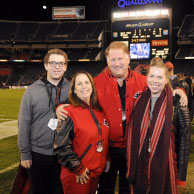
“Our legacy strengthens SDSU and sustains its growth as a serious institution of higher education.”
-Richard Fogg
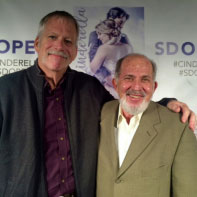
David Gubser
The Pride Center at San Diego State University has received a $100,000 gift from San Diego donor David Gubser.
Read more of his story
“At this time, given the terrible events in Orlando, people need to become more educated about the LGBT community,” Gubser said. “I couldn’t think of a better way to accomplish that goal than through a gift to SDSU.”
Gubser’s gift will create an endowed scholarship for LGBT majors and will expand the Pride Center’s programming to include academic mentoring, guest speakers, health and safety training and possible queer leadership conferences.
SDSU created its interdisciplinary LGBT studies program in January 2012 in the College of Arts and Letters. The university also offers a minor and a graduate-level certificate in LGBT studies.
“I am delighted by the generosity and foresight of David Gubser to endow a scholarship for LGBT studies students as well as to the Pride Center,” said Esther Rothblum, LGBT studies adviser at SDSU. “As we mourn the victims of the tragic shooting at a gay bar in Orlando, it is evident that now, more than ever, there is an urgent need for scholarship and activism that furthers knowledge of LGBT issues.”
SDSU has ranked among the top 25 LGBT-friendly universities in the nation for six consecutive years. The ranking is based on the Campus Pride Index, a tool that compares LGBT-friendly policies, programs and practices on college campuses. Christopher Lujan, Pride Center coordinator, said several students have visited the center in the last few days to ask about the services it provides.
“Often students want to go to a space where they are connected to the community,” Lujan said. “The Pride Center provides a space for all students to build a support system among the LGBTQ+ community at SDSU. Our services range from weekly support groups to utilization of our LGBTQ+ resources on and off campus.”
Charles and Robin Luby
Alumni Charles and Robin Luby have made a planned gift to support the SDSU Love Library and have a lasting impact on students. The gift, which will come from their estate, was announced when the couple received a Monty Award in 2010.
Read more of their story
“This generous gift from the Lubys will go a long way to enhance the education of all SDSU students,” said Jon Cawthorne, interim dean of SDSU Library and Information Access.
“The library is integral to student success. It supports research and class work, but sometimes just simply provides a quiet place to study. With this donation, we will be able to meet the changing needs of the modern student.”
The library is the most visited building on campus, with outstanding book, journal and special collections. Library computers, printers, wireless connections, study rooms and media are in constant use. Around-the-clock hours and website access support a new generation of students.
The San Diego couple have been active volunteers over the past several decades, at SDSU and in the community. Charles served as president of the SDSU Alumni Association Board of Directors and both he and Robin have supported committees on campus.
Charles, now retired from his career with General Atomics, received his bachelor’s (1959) and master’s (1964) degrees in chemistry from SDSU. Robin, a retired school teacher, also received her bachelor’s degree in English from SDSU in 1961.
“We’re very much committed to making the university continue to be the best it can and if there’s a way that we can help in what the goals are for the university, we’re going to do that,” Robin Luby said.
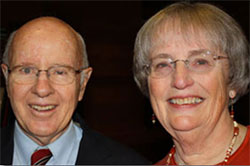
“We’re very much committed to making the university continue to be the best it can and if there’s a way that we can help in what the goals are for the university, we’re going to do that.”
-Robin Luby
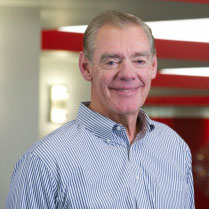
Jack McGrory
Jack McGrory, alumnus, faculty member, Campanile Foundation board member and passionate supporter of public administration, student veterans and classics and humanities, Jack has made extraordinary contributions to SDSU.
Read more of his story
“I’m proud of my education at SDSU,” said McGrory who is CEO of La Jolla MJ Management, Inc. “I would not be where I am today without my education, and I am thrilled to be able to help the programs that have meant so much to me thrive at San Diego State.”
McGrory has a distinguished resume that includes serving as chairman and CEO of Price Legacy Corporation, chief operating officer of The San Diego Padres, manager of the Price Group, executive vice president and director of Price Charities and San Diego’s city manager.
He also teaches a graduate-level course in public administration at SDSU, so it is no surprise that he supports the School of Public Affairs.
McGrory’s gift will continue to fund The Jack McGrory Internship Adviser in the School of Public Affairs. It will also create internships for undergraduate students in the school through the Jack McGrory Interns program and support a distinguished speaker series for the master’s of public administration urban studies program.
McGrory earned his bachelor’s degree in the classics and humanities from Colgate University in 1971 and believes strongly that the humanities provide the foundation for a successful intellectual, cultural and professional life.
To that end, his donation to SDSU’s Department of Classics and Humanities will provide scholarships for high-achieving students through the Jack McGrory Scholars; encourage travel abroad for students with financial need through the Jack McGrory Study Abroad Scholarship; and provide funding for high-achieving juniors and seniors to conduct collaborative research with SDSU faculty studying the humanities with the Jack McGrory Collaborative Research Fellows.
McGrory is also a U.S. Marine veteran, and his gift to SDSU’s Joan and Art Barron Veterans Center will secure staffing for the center, which serves as the hub for all student veteran support services at SDSU. This gift will also create an ongoing series of scholarships for student veterans.
Carey Wall and Terry O’Donnell
Professors emeriti Carey Wall and Terry O’Donnell have partnered on a gift to SDSU’s musical theater program. Their gift will endow a faculty position in the nationally renowned program and ensure SDSU’s musical theatre students will continue to have opportunities to learn from top faculty members.
Read more of their story
Students and graduates of the master of fine arts Musical Theatre Program have performed on and off Broadway, in regional theatres, in national and international tours, and on local stages. Perhaps most importantly, graduates ensure the legacy of this unique American art form by teaching in colleges and universities across the nation.
Wall is a professor emerita from the College of Arts & Letters. She was a professor of English (specializing in American Literature) for 37 years, and served as the department chair for a dozen years.
She is a founding member of SDSU Phi Beta Kappa Chapter, and since 2002 has been the chapter’s corresponding secretary. She has supported the musical theatre program for the last 10 years through scholarships and support of the archive.
“I’m impressed by the quality of the faculty’s work, by the changes they bring about in their graduate students in the course of two years, as well as in the research component of the master of fine arts program,” Wall said. “My gift will help to train the next generation of musical theatre educators for universities across the country. I hope others will contribute to the MFA in Musical Theatre program so the archive can be expanded and the graduate students can have access to an additional layer of specialized instructors.”
O’Donnell retired in 2008 after 35 years as a professor in both theatre and music. He is a founding member of the musical theatre master of fine arts program, and taught in the program since its inception in 1982. O’Donnell is well-known across campus as the carillonneur of the 204-bell University Carillon.
“Our unique MFA Musical Theatre curriculum is designed to balance both performance skills and scholarship; It is compelling to see what this program does to develop young artists,” said O’Donnell. “Over the last 30 years, I’ve observed our program graduates make extraordinary contributions both as artists and educators.”
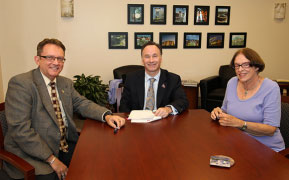
“I would not be where I am today without my education, and I am thrilled to be able to help the programs that have meant so much to me thrive at San Diego State.”
-Jack McGrory
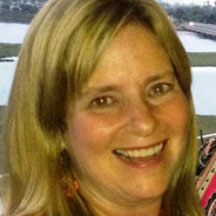
Wendy Reuben
When Wendy Reuben graduated from San Diego State with a Bachelor of Arts in Speech Communication, she knew making and maintaining connections with her classmates, professors and other organizational leaders would be key.
Read more of her story
She credits her involvement with San Diego Junior Chamber of Commerce, Public Relations Student Society of America (PRSSA), and Kappa Delta Sorority in creating some of the business relationships she currently holds.
After graduation in December of 1978, Wendy accepted internships that allowed her to hone the skills she learned at SDSU. After receiving Marketing/Communication Assistant positions at a variety of different PR companies for a couple years, Wendy received a referral to Price Club (which was later bought out by Costco) from a contact she knew through the San Diego Junior Chamber of Commerce, and she has been with Costco ever since. Volunteering and getting involved are two of Wendy’s passions. She’s so passionate about them in fact, her number one piece of advice for current SDSU students is to get involved and get an internship. She believes internships will help students use their book knowledge in a setting that will be critical in their futures. She also encourages students to volunteer at a non-profit or professional organization to create relationships and make connections that will get their name out to possible employers.
Ms. Reuben recently stated, “Alan Center and Barbara W. Hartung were very influential on me, as they were currently in the field while I was pursuing my degree. This helped me to keep up-to-date on exciting new advances in the field of communications. I am really thankful that SDSU provided me opportunities that I otherwise may not have had.”
So thankful in fact, she has decided to make a gift to San Diego State University through her will to benefit the College of Professional Studies and Fine Arts. Ms. Reuben’s gift and gifts like hers will allow generations of students at San Diego State University to continue making and maintaining connections with classmates, professors and organizational leaders while bettering their futures.
William Wade
Before he came to San Diego State College at age 20, William Wade witnessed things no young man should see. He saw the “utter devastation” of Tokyo after U.S. pilots firebombed the city during the Pacific Campaigns of WWII.
Read more of his story
For Fogg, this “homecoming” acknowledges SDSU’s rapidly growing role in the industry, fueled by the quality and quantity of its finance department graduates. To further solidify the partnership, Fogg has recruited young Aztecs to join the FPA board.
“We’re reconnecting the FPA with the heritage of SDSU’s program and ultimately, we’re reconnecting alumni with their alma mater,” said Fogg, president of Pacific Coast Financial Planning Group.
SDSU’s financial planning program was the first in the country to be offered at a fully accredited college of business. Upon completion, students can sit for the Certified Financial Planner (CFP) exam. Fogg joined the program after serving in the Navy. Now, he sits on the advisory board, matches students with mentors and helps find internship opportunities for future financial planners.
“Richard is a person who works extremely hard behind the scenes and doesn’t look for recognition,” said Thomas Warschauer, an SDSU finance professor and director of the financial planning program.
For three years, Fogg has also served on SDSU’s National Leadership Council, whose philanthropic mission is to enhance SDSU’s position as an international leader in teaching, research and service to the global community.
He and his wife, Sharon (’75), are long-time donors. They support the President’s Leadership Fund and are Director’s Cabinet members for SDSU Athletics, also providing scholarships for student-athletes.
Recently, the Foggs created and funded the Thomas Warschauer Endowed Director of Financial Planning to provide administrative support in perpetuity for SDSU’s financial planning program.
The couple said philanthropy has always been “an integral part of who we are,” and a tradition they’ve shared with their children, including Hannah, an SDSU finance major. Fogg also encourages other Aztecs to support SDSU.
“Whether through donation or mentorship, Aztecs need to reach out and contribute,” he said. “Our legacy strengthens SDSU and sustains its growth as a serious institution of higher education.”
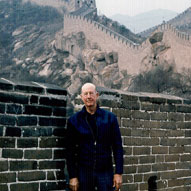
“I believe that providing scholarships for deserving students is an extremely good investment.”
-William Wade
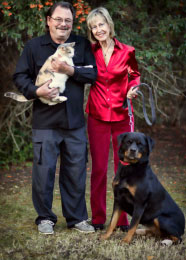
Gary Waer
Gary Waer never thought of himself as a lost Aztec, but he will concede he’s been “found.” A reception organized by San Diego State University for alumni in the Santa Barbara area last year reconnected Waer with the university 49 years after his graduation.
Read more of his story
The Santa Barbara function he attended led to meetings between Waer and SDSU’s College of Sciences dean and a visit to several campus chemistry labs. And that led to a gift from Waer and his wife, Barbara, to The Campaign for SDSU in support of science majors who’ve graduated from California high schools. “I was so impressed with the methodology in the labs and the fact that SDSU is producing working chemists — students who know their way around the labs. Our academic system doesn’t always teach hands-on science, but that should be the most important part of a chemistry education.”
Waer has always been the handson type. Born in Orange, California, he secured a paid internship with Shell Oil while still a student at SDSU.
After 13 years working with oil companies, primarily in management positions on both coasts, Waer settled in Solvang, California. An MBA from Pepperdine University gave him the experience to launch a construction engineering firm and revive a company he had founded years earlier to manufacture and sell synthetic oil for lubrication and cleaning.
Mobilizing his chemistry background, Waer also worked for nearly a decade to develop a chelating agent that increases a plant’s ability to absorb vital nutrients, such as calcium, copper and iron, from the soil. His research culminated in a Ph.D. degree in soils chemistry as well as a marketable product, MPXA, which Waer sells to a range of small growers and major agribusiness companies throughout the United States and in Mexico, the United Kingdom and the Netherlands.
“The entrepreneurship is as interesting to me as the science,” Waer said. “I have partners in England and the Netherlands trying to figure out how this product might increase yields in poor countries and enable farmers in arid regions to use salt water for irrigation.”
As adjunct professor of chemistry and biochemistry at SDSU, Waer is working with Distinguished Professor of Chemistry William Tong and his graduate students to further analyze MPXA. He also mentors a senior chemistry student. “The best thing we can do for SDSU is help students complete their degrees through mentoring and providing scholarship funds,” Waer said.
The College of Sciences is not their only passion. Barbara, an avid tennis player, has become a generous supporter and mentor to the Women’s Tennis Team. She enjoys meeting with the players and making a difference for the team.
Bonnie Zimmerman
Zimmerman began her career at SDSU as a lecturer in the Department of Women’s Studies in 1978. Since then, she has taught more than a dozen different courses at the university. She also served as department chair from 1986 to 1992 and from 1995 to 1997.
Read more of her story
In addition to teaching, Zimmerman was instrumental in developing courses to cultivate the growth of women’s and lesbian studies. “I was there from the beginning,” Zimmerman said. “I was a graduate student, I was in women’s studies, I was a lesbian, it all came together. When I came to San Diego State, it was an open and welcome environment … I was able to flourish because San Diego State was such an open environment.”
Zimmerman, along with Edith Benkov, later created lesbian, gay, bisexual and transgender courses in the mid-1990s. Although the courses began as a one-unit lecture series, they later expanded to three-units and became the foundation for the LGBT minor. The minor became official at the start of the 2009–10 academic year, making SDSU the third university in the California State University system to offer it.
Zimmerman has gained an international reputation for being one of the earliest pioneers in the field of lesbian studies. She has published numerous articles, as well as three books and an encyclopedia on lesbian histories and cultures.
“Bonnie Zimmerman is a model of what someone who works at the university should be,” Benkov said. “(She is an) excellent teacher, excellent scholar and someone who really gave her life to university service as well for the bettering of the university and its faculty and its students.”
Zimmerman has chosen to support Women’s and LGBT Studies and has said her love for SDSU kept her from pursuing opportunities at other universities. “I got so much support,” she said. “(SDSU) allows people to do what they want to do, not what the mainstream says you have to do. That was really great for me.”
“This is such a fabulous university; sometimes people don’t realize how fabulous it is,” Zimmerman said. “This is a place that allowed me to just do everything and be everything that I could be.”
In 2010, after 32 years of service, Bonnie retired from SDSU. Though she is no longer teaching, she continues to contribute to student success. Bonnie has designated a portion of her retirement pay to be deducted monthly and donated to SDSU. She has found this to be an easy way to further her giving.
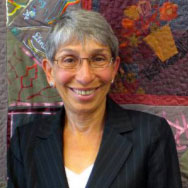
“The best thing we can do for SDSU is help students complete their degrees through mentoring and providing scholarship funds.”
-Gary Waer
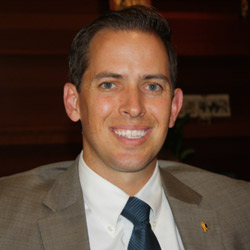
Sean Kilkenny
Alumnus Sean Kilkenny completed his MBA at San Diego State University in 2010. With over 10 years of experience in residential real estate development, Sean is currently the forward planning director at Davidson Communities.
Read more of his story
He was influenced to enter the real estate profession by his desire to develop great communities and by his father, Kim Kilkenny ’74, who was deeply involved in the development of Otay Ranch.
Just four years after receiving his MBA, Sean made a planned gift to provide support to working students in the MBA program in the Fowler College of Business Administration at San Diego State. Sean has also served as a mentor in the SDSU Aztec Mentor Program and sits on the Alumni Association Board of Advisors. He and his wife, Maddy, are proud parents to young sons, Logan and Owen.
Robin and Bill Sinclair
On the heels of a successful campaign for the Jeff Jacobs J.A.M. Center and its basketball programs, San Diego State University Athletics has launched a campaign to provide scholarship support for student-athletes.
Read more of their story
“We are pleased to announce a $1.25 million estate gift from Robin and Bill Sinclair to launch the Coryell Legacy,” said SDSU Director of Athletics Jim Sterk. “The Sinclairs were first time donors to the university in 2012 and have quickly become very passionate supporters of the Aztecs.”
Named in honor of Don Coryell, the winningest coach in Aztec football history, the Coryell Legacy will be funded through endowments and estate gifts for Aztec Athletics. With an endowment goal of $20 million, the Coryell Legacy will help ensure the financial future of the Department of Athletics and the success of its student-athletes.
In making an estate gift to the Coryell Legacy, the Sinclairs signaled their support for the academic and the athletic achievements of SDSU.
“Bill and I are not alumni, but we love the Aztecs,” Robin said. “From the personable student-athletes to the hard working coaches and staff, we feel SDSU Athletics is a perfect match for our philanthropic priorities, and we are pleased to make this commitment in addition to our annual giving.”
Bill compared building an endowment to building a sports team — a steady stream of new recruits maintains the program’s strengths. “Legacy giving will keep the university growing and guarantee its future,” he said. The Sinclairs’ gift supports The Campaign for SDSU, which has raised more than $750 million. Through the campaign, SDSU has received gifts from alumni, friends, faculty, staff, parents and community partners.
For more information on the Aztec Club and the Coryell Legacy, please contact the Aztec Club at 619-594-6444 or visit https://sdsuaztecclub.com/.
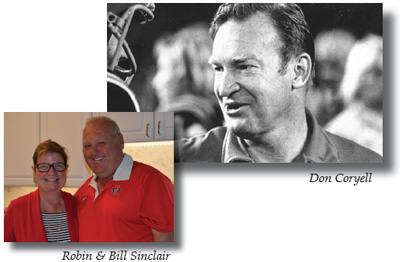
“Legacy giving will keep the university growing and guarantee its future.”
-Bill Sinclair
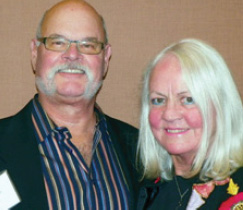
Larry Petersen
The year was 1971, and Larry Petersen was feeling confident. He could see the individual pieces of his SDSU education fusing in a practical test of entrepreneurial ability.
Read more of his story
Petersen had taken an extra year at SDSU, supplementing the requirements of his marketing degree with classes in psychology and industrial arts. Now it was time to put his knowledge to work on a senior project.
“This was a real test of entrepreneurship before there were any entrepreneurship majors,” Petersen said. “We worked in teams—using all the skills and information we had acquired— to develop a viable company.”
Petersen believes the brand of innovative thinking he learned at SDSU “stays with you for life.” An entrepreneur, he said, “will understand how to move the company forward in a strategic way that CFOs and other managers aren’t familiar with.”
He should know. Before retiring, the Petersens received more than 100 national awards for sales and marketing excellence in the course of founding and developing three successful companies—LP Marketing, a representative sales and marketing firm for manufacturers of high quality consumer electronics; Bayview Distributing, an electronics distribution arm for 30 manufacturers; and Bayview Development, which buillt custom homes in the Oakland area.
In 1999, a gift from Petersen and his wife, Madeline, created SDSU’s Entrepreneur-inResidence program. This program helps link the college to the local business community by providing the necessary experience to guide the college’s students and faculty to those resources that connect classroom lessons and real-world business practices. In 2011, the Petersens made a planned gift to ensure its continued success in the future.
For many years, Petersen has been a judge for SDSU’s Venture Challenge business plan competition, or-ganized by the Lavin Entrepreneurship Center.
It’s important to the Petersens that SDSU continue to foster an entrepreneurial spirit in today’s students. The couple’s recent decision to bequeath $2 million of their estate to the Lavin Entrepreneurship Center will generate new opportunities for the center to expand and develop links with each of SDSU’s seven colleges—in short, to teach every student to think like an entrepreneur.
William E. Leonhard, Jr.
When William E. Leonhard, Jr. came to San Diego to earn an engineering degree in 1959, he did not know much about San Diego State University or where his degree would take him. What he graduated with, however, was more than a bachelor’s degree.
Read more of his story
A 1964 engineering graduate, Leonhard maintains close ties with San Diego State despite living across the country in Florida. He is a member of the National Campaign for SDSU Leadership Council and serves on the College of Engineering advisory board.
Leonhard feels strongly about giving back to SDSU for providing him the education and tools to succeed as an engineer. Now is the time, he says, for alumni to help current and future students secure a college degree.
“You don’t have to be a billionaire to give money back to the university. It doesn’t take a lot of money over a long period of time to endow a scholarship.”
The William E. Leonhard Chair in Civil and Envivironmental Engineering is funded by an endowment created with gifts from Leonhard and his parents, William E. and Wyllis M. Leonhard. It will enable SDSU to attract and retain the most accomplished faculty in these fields.
Another gift, the William E. Leonhard Jr. Scholarship Endowment, will support scholarships for graduate and undergraduate engineering students.
“This country needs more highly-educated technical personnel,” said Leonhard. “Universities can’t do this work by themselves anymore, especially state universities where the legislatures are [financially] cutting back. Individual alumni need to pick up the slack. We need to show that providing access to quality education is important.”
After retiring from the Air Force as a colonel, Leonhard became senior program manager for The Parsons Corporation, where he managed the design of themed rides for Disney Parks. He was also site manager for a 5-millionsquare-foot computer manufacturing and development site and he consulted on the construction of a computer chip manufacturing plant in Oregon.
Today, Leonhard reflects that his years at SDSU gave him the knowledge and skills to succeed in his career. Not until he left San Diego to work on a master’s degree at another university did he realize the value of his undergraduate education.
“Interestingly enough [when I went to Arizona State University], I got better grades than I expected,” said Leonard. “It made me realize that the education at SDSU was of a much higher quality than I had thought. I am still grateful for that.”
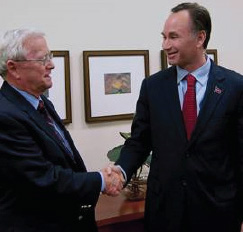
“This country needs more highly-educated technical personnel. Universities can’t do this work by themselves anymore, especially state universities where the legislatures are [financially] cutting back. Individual alumni need to pick up the slack. We need to show that providing access to quality education is important.”
-William E. Leonhard, Jr.
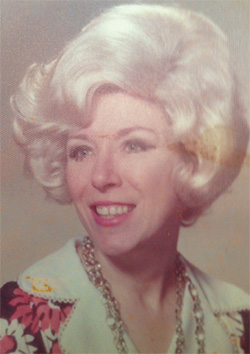
Barbara Meyers
“With hard work, you can do anything,” is the advice Barbara Meyers’ niece and nephew recall as their late aunt’s philosophy for living life.
Read more of her story
Born in 1931 to Charles and Helen Rappe in Hobart, Indiana, Barbara Meyers was the first in her family to attend and graduate college. She came from a loving, working class family, and was taught from a young age the value of a dollar, and the importance of hard work. She was a diligent student and attended Indiana University where she studied Elementary Education. Shortly after graduation, Barbara followed her dreams to California where she taught first and second grade in the San Diego school system for over fifty years. One of Barbara’s greatest career achievements was ensuring every student that left her classroom was a cognitive reader and that they could read at grade level. A lesson her students and their future teachers were all very thankful for.
A lifelong learner, Barbara traveled the world learning about other countries and cultures. However, it was San Diego that always felt like home. After a lifetime of living well beneath her means, and some savvy investing, Barbara had built herself a nice estate which she hoped to use to help support others.
She established a scholarship named in her parents’ memory at SDSU to help support students studying Elementary Education. Barbara named the scholarship after her parents to honor the love and support they provided throughout their lives. Helen and Charles were Barbara’s first teachers, instilling a strong work ethic through their example of perseverance and dedication.
In true Barbara fashion, the Helen and Charles Rappe Teaching Excellence Endowed Scholarship has a merit component to its eligibility criteria. Students must be enrolled full-time and be in good academic standing, and meet a minimum GPA requirement to be considered for the scholarship. There is also a financial need element to the scholarship. It was important to Barbara that it be awarded to those who need financial assistance and demonstrate strong academic performance. Recipients are awarded 50% of the cost of their teaching credential program and annual tuition fees. In creating the scholarship, Barbara sought to reward those who are committed to educating others. Teaching was not only Barbara’s profession, it was her passion. Her lesson will continue long into the future as generations of recipients of the Helen and Charles Rappe Teaching Excellence Endowed Scholarship follow Barbara’s philosophy of lifelong teaching and lifelong learning through hard work.
Mark Linsky
“Find your passion. Follow it, and life will fall into place for you,” is the advice planned giving donor Mark Linsky would like to pass on to current Aztecs.
Read more of his story
Mark first discovered his passion for political science during his favorite class — a political science seminar. “It taught me a huge amount about the difficulty of conflict resolution on the world stage.” Over time, that passion has grown into teaching the “value of civil society in an age of suspicion, repeating the mantra that a public office is indeed a public trust in a democratic society, and reminding my students that they should not judge lest they be judged.”
In addition to obtaining both his Bachelors and Masters degrees in political science, Mark worked in government for the City of San Diego as part of the mayor’s classified staff and as coauthor of a study of crime in San Diego. All the while, Mark’s desire to teach was calling him. Taking advice from one of his professors at SDSU, Mark applied to teach political science for the U.S. Navy where he taught classes both ashore and afloat while traveling the Pacific, including the Philippines and Japan. He reflects on this period as a “time of learning and adventure”. After his teaching adventures at sea, Mark secured a position as an adjunct professor at San Diego City College/ Mesa College where he has taught for the past 25 years.
Mark has a lot to be thankful for and regards his role as a good husband to his wife, Mary Jane, and loving father to their son, Jake, and daughter, Jordan, as his highest ranking achievement. Professionally however, he is most proud of winning the Weinberger Law History Award through the San Diego Historical Society. Mark has also been an amateur triathlete for 20 years which he credits for teaching him about discipline and commitment.
Mark is thankful for his time at SDSU. “I’m fortunate enough to have won a lottery of sorts. I don’t believe in the sour saying that ‘he who dies with the most toys wins’. Winning means doing the best we can for our families, friends, neighbors and community. Whatever I am today — values, interests and moral bearing — I owe in large part to SDSU and the university community that nourished me. I made a smart choice coming to Montezuma Mesa and I want future generations of Aztecs to benefit just as I did.” For this reason, Mark and Mary Jane have made a planned gift, in hopes that as students go out into the world, they will be able to credit their own values, interests and moral being in large part to SDSU.
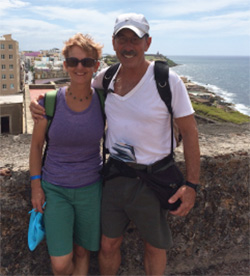
“Whatever I am today — values, interests and moral bearing — I owe in large part to SDSU and the university community that nourished me.”
-Mark Linsky
Join a Giving Society
Join a community of people who share your passion for changing students’ lives by becoming a member of one of our giving societies.
